
Prepared for Health Canada
Prepared by Narrative Research
PSPC Contract Number: CW2318794
Contracted Value: $144,577.85
Contract Date: 2023-06-16
Delivery Date: 2023-11-08
POR number: 018-23
For more information, please contact: HC.cpab.por-rop.dgcap.SC@canada.ca
Ce rapport est aussi disponible en français
Final Report
Supplier Name: Narrative Research
November 2023
This public opinion research report presents the results of focus groups conducted by Narrative Research on behalf of Health Canada. The research entailed two phases. The first phase included a total of five focus groups, namely one in each of five regions, while the second phase included a total of 20 focus groups in these same regions: Atlantic Canada, Ontario, Quebec, the Prairies/Northwest Territories/Nunavut, and British Columbia/Yukon. The target audiences included people from the general population (Phase 2 only); parents or guardians of children under the age of 18 years old; seniors over 65 years of age; people living with disabilities; and people residing in remote communities (located at least 100km from the nearest permanent dental professional). Phase 1 sessions each included a mix of target audiences, while sessions in Phase 2 were segmented by audience. All participants reported having a household income of less than $90,000, and 70% of participants in each group reported not having private dental insurance coverage, while 30% did. The Quebec and Francophone (Quebec/New Brunswick) sessions were conducted in French, while all other discussions were held in English. The fieldwork was conducted from July 11-13, 2023 for Phase 1 and from October 12-19, 2023 for Phase 2.
Cette publication est aussi disponible en français sous le titre :
Test en groupes de discussion du Régime canadien de soins dentaires
This publication may be reproduced for non-commercial purposes only. Prior written permission must be obtained from Health Canada. For more information on this report, please contact Health Canada at: cpab_por-rop_dgcap@hc-sc.gc.ca
Catalogue Number:
H14-580/2024E-PDF
International Standard Book Number (ISBN):
ISBN 978-0-660-70273-5
Related publications (registration number: POR 018-23):
Catalogue Number H14-580/2024F-PDF (Final Report, French)
ISBN 978-0-660-70274-2
© His Majesty the King in Right of Canada, as represented by the Minister of Health, 2023
Narrative Research Inc.
Contract Number: CW2318794
POR Registration Number: 0018-23
Contract Award Date: 2023-06-16
Contracted Cost: $144,577.85
Health Canada intends to implement the Canadian Dental Care Plan to provide dental coverage for uninsured Canadians with annual family incomes of less than $90,000, with no co-pays for those with family incomes under $70,000. The plan will be rolled-out initially for seniors, children under the age of 18, and people with disabilities who meet the other eligibility criteria. People living in rural and remote communities as well as racialized communities will also be a key focus for the new program. Once fully implemented, the plan will provide dental coverage for up to nine million Canadians.
In this context, Health Canada intends to refine communications and marketing activities for this entirely new initiative, set to launch in late 2023 and into 2025. A marketing campaign will be launched with the goal to raise awareness about the plan among all eligible Canadians, with an emphasis on priority audiences which include seniors, people with disabilities and parents of children under 18. Prior to finalizing the creative approach for the look and feel for the Canadian Dental Care Plan and the advertising campaign materials, Health Canada is interested in testing reactions to various concepts and messages, with the goal of informing the development of the final creative.
The objective of the research is to evaluate and gather feedback on several potential creative approaches and key messages among various groups of eligible Canadians to determine what direction(s) best resonates with the target audience(s).
Specifically, the first phase of the research examined options for the program look and feel, while the second phase of the research helped inform the choice of a specific creative approach. Each phase of the research was designed to help determine if the material tested was:
In addition, the research was designed to:
The results of this study will be used to direct Health Canada’s decision concerning the development of creative concepts for communications materials related to the Canadian Dental Care Plan for the campaign unfolding later in 2023. Specifically, the first phase of the research examined options for the program look and feel, while the second phase of the research helped inform the choice of a specific creative approach for the upcoming advertising campaign.
To achieve these objectives, a two-phase qualitative research approach was undertaken. Target audiences for both phases included: parents or guardians of children under the age of 18 years old; seniors over 65 years of age; people living with disabilities; and people residing in remote communities (located at least 100km from the nearest permanent dental professional). In addition, members from the general public were included in Phase 2. In both phases, all participants had a household income of less than $90,000. For each group, seven participants did not currently have private dental insurance coverage, and three had private dental insurance coverage. Each group included a mix of genders and ethnic background. The regions included in the research were also the same for both phases, namely: British Columbia/Yukon, Prairies/Northwest Territories, Ontario/Nunavut, Quebec, and Atlantic Canada). While the Quebec and Francophone (Quebec/New Brunswick) focus group discussions were held in French, all others were conducted in English. Participants received $125 in appreciation for their time.
The first phase entailed a total of five focus groups with a mix of the target audiences attending. Each session lasted approximately 90 minutes, and across groups, a total of 50 individuals were recruited and 43 participated. The second phase of research entailed a total of 20 focus groups, namely one session per region with each of the members from the general public, parents/guardians, and seniors 65+; three sessions with people living with disabilities (West, Ontario/Atlantic, Quebec/Atlantic); and two sessions with people living in remote communities (East/North and West/North). Each session lasted between 90 minutes and two hours. From 200 recruited individuals, 172 participated in a session. Due to technical issues, three participants were unable to attend the sessions but were incentivized, as is normally the practice in market research.
All participants were recruited per the recruitment specifications for the Government of Canada. Recruitment was conducted through qualitative panels stored on Canadian servers, with follow up calls to confirm the details provided and to ensure quotas were met.
This report presents the findings from both phases of the study. Caution must be exercised when interpreting the results from this study, as qualitative research is intended to be directional only. Results cannot be attributed to the overall population under study, with any degree of confidence.
I hereby certify as a Representative of Narrative Research that the deliverables fully comply with the Government of Canada political neutrality requirements outlined in the Directive on the Management of Communications. Specifically, the deliverables do not include information on electoral voting intentions, political party preferences, standings with the electorate or ratings of the performance of a political party or its leaders.
Signed:

Margaret Brigley, CEO & Partner | Narrative Research
Date: November 8, 2023
Barriers to Dental Care
Financial considerations are by far the main barriers to seeking more regular dental care, even among those with dental insurance coverage. Anxiety, notably the fear of pain, is also top-of-mind, while accessibility is an issue raised by those living in remote or rural locations.
Awareness of Financial Assistance
While there is knowledge of the provincial or territorial dental coverage programs available to seniors and children, virtually no one recalled having heard of the Canada Dental Benefit by name or any other federal government programs available to assist with the cost of dental care. That said, some parents are aware of the benefit for children under 12, although they do not spontaneously associate it with the Canada Dental Benefit. For those who are aware of government programs, program awareness stems from the Canada Revenue Agency, Service Canada or a dental professional.
Concept Testing
During the focus groups, participants were presented with three concepts that presented a ‘look and feel’ for communications materials related to the Canadian Dental Care Plan. Each concept was presented and discussed one at a time, with the presentation order rotated across groups to minimize any presentation bias. Following the discussion of all three concepts, participants were asked to choose which one is most likely to grab their attention in a positive way and perhaps make them want to find out more about the Canadian Dental Care Plan.
Overall Reactions Across Concepts
A number of graphic elements elicited similar comments across the concepts tested. More specifically, the font was appreciated for being approachable, warm, friendly, and easy to read, while providing a casual and inviting vibe. This tone is supported by showing visuals of smiling and happy people, though the individuals shown appeared a little too ‘perfect’ and ‘staged’ to be relatable. Showing a variety of body-type and facial features, as well as diversity in the types of smiles and dental status would make any of the three concepts more engaging.
At the same time, none of the visuals effectively communicate the topic of dental care. Further, they fail to show how good oral hygiene contributes to a healthy lifestyle, thus supporting the importance of seeking regular dental care. Showing situational instances where someone’s teeth are cared for during daily activities would draw attention (e.g., someone eating an apple or an amateur sports player wearing a mouth guard), as long as the types of care shown is covered by the Plan.
The three concepts currently show individuals from various backgrounds and demographics to varying degrees, generally suggesting that the Plan is all-inclusive, but with a special focus on seniors, children and visible minorities. In selecting the visuals for the final concept, care should be taken to achieve a good representation in terms of ethnic background, age, and gender.
Concept A (Purple Shade)

Overall reactions to this concept were mostly positive, notably for the ‘clean’, calm, simple and professional design. Despite appeal for its simple graphic design and muted tone, this concept lacks strong visual impact and personal relevance. The colours are soothing but somewhat passive and lacking a sense of excitement. Despite being evocative of a smile, the purpose for the background motif is not clear and while it contributes to making the approach look more dynamic, it is seen by some as distracting. The choice of visuals seems skewed towards visible minorities, suggesting that the program is primarily for newcomers. Images are also more family oriented and inclusive of seniors than the other concepts. In general, the concept lacks personal relevance by failing to illustrate more realistic people and situations. That said, having people look directly at the camera is engaging. Overall, this concept has more of a generic and corporate design which is closest to what is expected of ‘typical government’ material.
Concept B (Curved Design)
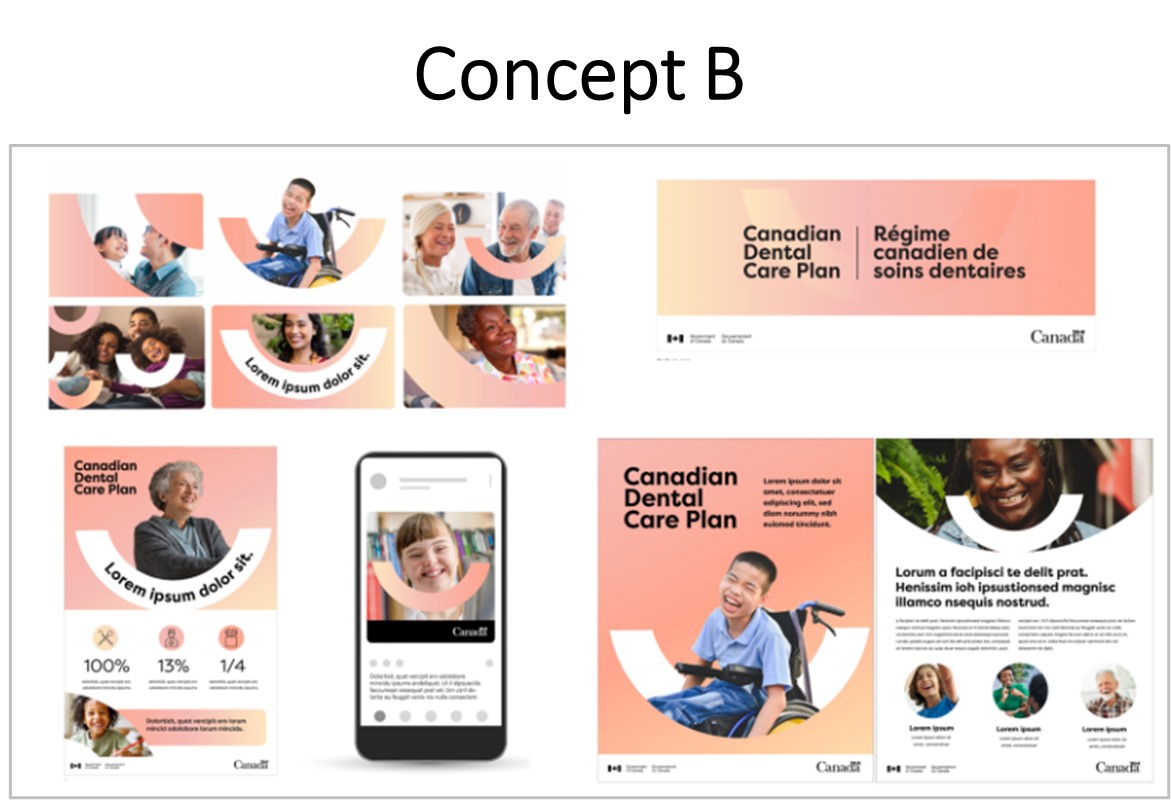
This concept elicited mixed reactions. The bright, warm, and unusual colour grabbed the attention of some, while others disliked it. Some found the visual components interesting and modern, while others felt that it made the concept look cluttered and took away the focus from the message. That said, most disliked the graphic shaped like a smile for obstructing the images, being too rigid and not readily suggestive of a smile. The use of statistics and ratios is liked and draws attention to important information, as long as the information is easy to understand and meaningful. This concept’s visuals held a little more personal relevance than the other two, for showing more realistic and ‘imperfect’ people, some of whom look genuinely happy. There is also a greater diversity of smiles represented.
Concept C (Abstract Smile)

This concept was felt to be the least visually interesting of all three, due to low contrast, a white background, muted tones, and visual clutter. The semi-circle graphic was not readily associated with a smile and the way it frames images or is shown on top of images is distracting and confusing. That said, the design gives the impression that more information would be provided, and there is some appeal for the way the text is divided in paragraphs or blocks. Further the presence of statistics and pictograms grabbed attention. While this concept speaks to a broad audience, some felt less compelled by it as it focuses on select demographic groups, including seniors and newcomers.
Concept Preference
Concepts A and Concept B are equally preferred among English participants, while French-speaking participants expressed a preference for Concept C, with split opinions on Concept A or B being second. Concept A is preferred for its uncluttered design, its simplicity, the calm colour palette, and simple graphic elements that does not overpower the images. Concept B is preferred for its attention-grabbing and warm colour scheme, dynamic design, and for showing images of people with more genuine smiles. Both held appeal for having some visuals of people looking directly at the camera. French-speaking participants preferred Concept C for the appearance of being more informative and for the manner in which the information is presented in paragraphs or blocks of text.
Regardless of the final concept, social media, traditional media (notably television and radio), direct mail, and brochures or posters in health-related public location were see as the best way to inform the public about the Canadian Dental Care Plan.
Key Messaging
Participants were also shown seven statements and asked for their general feedback, as well as being asked to choose which one would be most likely to encourage them to search for more information on, or enroll for, the Canadian Dental Care Plan, and which statement they prefer overall. The statements included:
The tagline “Accessible. Affordable. Essential.” was by far the preferred and deemed most effective across groups, for addressing the main barriers to seeking dental care. That said, it is a strong promise that creates high expectations about the plan. The tagline “Dental care you can depend on,” was also the most liked for the reassurance it provides.
Prior to discussing the creative material, participants were asked to briefly explain some of their choices related to their own dental care, or that of other people in their household.
Barriers to Dental Care
Cost is a major barrier to dental care access, and fear of pain, anxiety and past negative experiences also hindered some individuals. Residents in remote areas face travel and availability issues, while those living with disabilities mentioned accessibility concerns. Less frequently cited obstacles included time constraints and inconvenient hours.
Awareness of Financial Assistance
Some individuals in each group were already informed about the Canadian Government’s future plans to provide dental care coverage, though the majority lacked specific information. A small number had learned about these initiatives from sources such as the Canada Revenue Agency website or various news outlets.
Concept Testing
Participants were shown three creative concepts for communications materials, each including a video, print and digital banner advertisement. Each concept was presented and discussed one at a time, with the presentation order rotated across groups to minimize bias. Participants were asked to focus on the message and idea or approach, given that sketches were used (rather than fully produced advertisements).
Overall Reactions
It is clear that participants generally gravitate towards more simple messages that are clearly presented. Regardless, participants are happy to learn of the program’s upcoming arrival, particularly given that the cost is the main barrier to going to the dentist. The tagline used in some of the concepts was generally well received, however, there is a need for more clarity regarding the target audience.
Furthermore, the materials that were tested prompted participants to have a lot of questions about the new dental care program, such as who qualifies, what would be covered, etc. Participants also noted that some elements of wording caused confusion and need to be re-assessed upon further consideration. Relatedly, care must be taken not to make any audience feel that they are being talked down to, stereotyped or infantilized as this impression can provoke strong negative reactions. Lastly, showing a diverse group of people and types of family situations suggests that the Canadian Dental Care Plan is inclusive of all, though to ensure understanding, the use of diversity should not overshadow the program messaging.
The three concepts currently show individuals from various backgrounds and demographics to varying degrees, generally suggesting that the Plan is all-inclusive, but with a special focus on seniors, children and visible minorities. In selecting the visuals for the final creative concept, care should be taken to achieve a good representation in terms of ethnic background, age, and gender.
The creative concepts are summarized below.
Concept A (Smiles)

Positive reactions to this concept were overshadowed by the focus on smiles, leading many to confusion or a belief that the most important part of the dental care is the cosmetic part. Many felt the smiling images were inappropriate for a serious topic and that the headline was not clear in what it was trying to communicate. That said, participants largely stated they would attempt to seek more information after seeing the concept. Many appreciated the great level of diversity presented in the concept, while others felt it superseded the intended message about dental care. The upbeat music also grabbed attention, and although most enjoyed the upbeat cheerfulness, a few felt it to be off-putting.
Concept B (Tooth Fairy)

Alternative
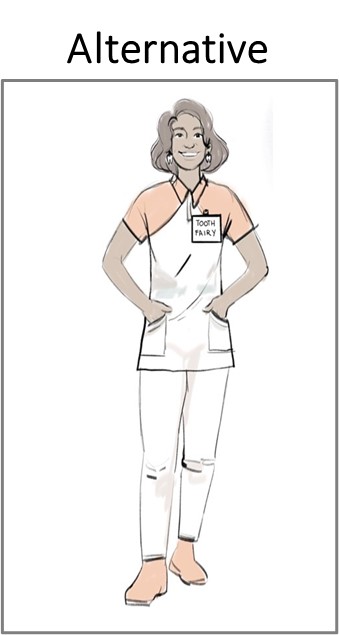
This concept elicited mixed reactions as the ‘tooth fairy’ approach only resonated with a few, and many found it offensive or confusing. While the concept was fun and nostalgic, seniors and those living with disabilities found it to be condescending. Despite all the strong reactions, the message was still clearly understood and many would seek more information about the program. Conversely, participants were somewhat unsure who the target audience was intended to be, whether it be families, children or seniors. The alternative tooth fairy portrayal also received mixed reviews with some having preferred the magical approach and some having preferred a more medical / clinical appearance.
Concept C (Simple Facts)

This concept was the overall preference of participants, primarily due to its level of clarity, relatability, and straightforwardness. Many also appreciated the seriousness of the approach, rather than something that was perceived to be more cosmetic or silly. Generally, the concept was said to be believable, and it would grab the attention of participants. The ‘frozen peas’ scenario was nearly universally relatable to participants. That said, some highlighted that the individual in pain is portrayed in a stereotypical way, with the younger person ‘knowing it all’ and the older person being weak and oblivious. For that reason, some seniors found it condescending, despite the scenario itself being very relatable (being in pain but not going to the dentist). The concept, overall, was deemed the strongest and the one that would motivate participants to investigate the program further.
Concept Preference
Following the discussion of each of the three concepts, participants were asked to choose which one is most likely to grab their attention in a positive way and perhaps make them want to find out more about the Canadian Dental Care Plan.
Concept C (Simple Facts) was the top choice among all groups, with most participants finding it the most enticing and clear for conveying information about the new dental care program. Its relatable and lighthearted approach was widely appreciated. By contrast, Concepts A (Smiles) and B (Tooth Fairy) were chosen by only a few, with Concept A being liked for its positivity, while Concept B was seen as appealing to children and families.
Regardless of the final concept, social media, traditional media (notably television and radio), direct mail, and brochures or posters in health-related public locations were seen as the best way to inform the public about the new Canadian Dental Care Plan.
Health Canada intends to implement the Canadian Dental Care Plan to provide dental coverage for uninsured Canadians with annual family incomes of less than $90,000, with no co-pays for those with family incomes under $70,000. Once fully implemented, the Canadian Dental Care Plan will support up to 9 million uninsured Canadians who have an annual family net income of less than $90,000.
In this context, Health Canada intends to refine communications and marketing activities for this entirely new initiative, set to launch in late 2023 and into 2024. A marketing campaign will be launched with the goal to raise awareness about the plan among all eligible Canadians, with an emphasis on priority audiences which include seniors, people with disabilities and parents of children under 18.
The objective of the research is to evaluate, and gather feedback on, several potential creative approaches and key messages among various groups of eligible Canadians to determine what direction(s) best resonates with the target audience(s).
Specifically, the first phase of the research examined options for the program look and feel, while the second phase of the research helped inform the choice of a specific creative approach for the upcoming advertising campaign. Each phase of the research was designed to help determine if the material tested was:
In addition, the research was designed to:
The results of this study will be used to direct Health Canada’s decision concerning the development of creative concepts for communications materials related to the Canadian Dental Care Plan for the campaign unfolding later in 2023.
The target audience for the study included Canadians 18 years and older with an annual household income (HHI) of less than $90,000 from the following segments:
The study entailed two phases, specifically:
In total, ten people were recruited for each session. Each group discussion lasted between 90 minutes and two hours and participants received a cash incentive of $125 in appreciation for their time. The Quebec and Francophone (Quebec/New Brunswick) groups were conducted in French and all others in English.
Recruitment aimed to represent a mix of ages, genders, and ethnic backgrounds. Although the Canadian Dental Care Plan will only be available to Canadians with no private dental insurance coverage, each session included a mix of participants with and without insurance (70% without insurance and 30% with insurance through an employer, pension plan, or an individual benefit plan they purchased).
All participants were recruited per the recruitment specifications for the Government of Canada. Recruitment was conducted through qualitative panels stored on Canadian servers, with follow up calls to confirm the details provided and to ensure quotas were met. Those with current or past employment in sensitive occupations were excluded from the research, in addition to those who have others in the household in these types of work. These sectors included marketing, marketing research, public relations, advertising, media (TV, radio, newspaper), graphic design, provincial or federal government departments or agency related to healthcare, as well as dental or insurance industries. In addition, individuals who have been to at least five qualitative sessions in the past five years, those who have attended a session in the past six months, and those who have participated in group discussions related to advertising and communication materials were excluded from the research during the recruitment process.
Qualitative discussions are intended as moderator-directed, informal, non-threatening discussions with participants whose characteristics, habits, and attitudes are considered relevant to the topic of discussion. The primary benefits of individual or group qualitative discussions are that they allow for in-depth probing with qualified participants on behavioural habits, usage patterns, perceptions and attitudes related to the subject matter. This type of discussion allows for flexibility in exploring other areas that may be pertinent to the investigation. Qualitative research allows for more complete understanding of the segment in that the thoughts or feelings are expressed in the participants’ “own language” and at their “own levels of passion.” Qualitative techniques are used in marketing research as a means of developing insight and direction, rather than collecting quantitatively precise data or absolute measures. As such, results are directional only and cannot be projected to the overall population under study.
Prior to discussing the creative material, participants were asked to briefly explain some of their choices related to their own dental care, or that of other people in their household. To provide context, participants were asked to specify the approximate frequency at which they have gone to the dentist in the past few years. Across groups, just over half of participants report going to the dentist at least twice a year, or about once a year, while others visit a dental office less often.
Financial considerations are by far the main barriers to seeking more regular dental care.
When asked what might prevent them or others in their household from going to the dentist at all, or from going more often, cost was consistently identified by participants as the most important barrier. As a result, they either do not seek regular dental care, or they extend the period between cleaning appointments. Even those with dental insurance report not always obtaining the treatments they require due to the cost if it is not fully covered by their insurance.
“We are business owners and [inherently] we do not have medical coverage. I have been battling with half of a tooth for the better part of five years.” – Atlantic
“I am lucky enough to have dental insurance but it does not cover much of the cost. The costs have gone up.” – Atlantic
“We have gone every six months until we did not have insurance because it is prohibitively expensive if you have five children. We are now pushing nine months and ensuring the kids go before us.” – Ontario
“For us, even though we both make good money it is still a financial concern. Right now, I need to have a crown, so I need to save money for a crown. [The main barrier] is cost.” – British Columbia/Yukon
Anxiety, or fear, is also mentioned by a few as preventing some participants to seek dental care, either resulting from a bad previous experience, or based on the fear of the unknown or the fear of pain.
“I also have a fear of dentists. It is hard to find one that has care and feeling for people who are scared.” – Atlantic
“Once you go there once, you have an infection that does not heal well that is where the anxiety comes up.” – Prairies/Northwest Territories
“Not liking the dentist and having to deal with the pain and the fear of being hurt. It is unpleasant and there is the discomfort and knowing I will have to take the next day off because of the pain.” – Ontario
Those living in small or remote communities are limited by the number of dental offices available and the long wait time to secure an appointment.
“Finding a dentist is difficult. There are only a couple around here. You are waiting 7 months to see them.” – Atlantic
Other less commonly cited barriers to accessing dental care include a lack of time, inconvenient business hours that require that patients take time off work, the difficulty in finding a dental care professional that offers flexible payment terms, mistrust in the advice provided by dental professionals, mobility issues, and being embarrassed about the condition of their teeth.
“It’s hard… when I am working 8 to 4:30 weekdays a lot of dentists are not working weekends. I don’t like to take time off work.” – Prairies/Northwest Territories
“Finding a dentist that would work with me for a payment plan was difficult. I had to work around and look for a dentist to do that.” – Prairies/Northwest Territories
There is minimal awareness of government programs available to assist with the cost of dental care.
Very few participants across groups report having heard of any government programs related to dental care, and even among the few who have, very little is known about those programs.
“I have not heard of any assistance for dental care. The only thing that was offered by my dentist was [I] go to the dental school in Halifax.” – Atlantic
“I have looked around and I have not come across those programs. Either they are well hidden or you have to scratch for them and find them.” – Prairies/Northwest Territories
Some currently receive provincial or territorial dental benefits. A few parents report that children 12 and under can access free dental care. Meanwhile, a few believe that dental benefits are available to seniors.
“I know that for kids if you have low income the federal government has grants.” – Prairies
Program awareness stems in part from three sources, namely the Canada Revenue Agency, Service Canada, or a dental professional. Of note, a couple of participants mentioned that while they believe financial assistance for dental care might be available, they have not investigated these opportunities as they are under the impression that they would not qualify given their household income.
“I think through Service Canada or the CRA. There was a page that came up to apply for a dental rebate but I am not sure. I don’t usually get approved for those kinds of things so I did not apply.” – Atlantic
“À la télévision et aussi l’Agence du revenu du Canada. Je n’ai pas lu l’information parce que j’ai l’impression que je ne rentre pas dans le panier du gouvernement et j’ai une assurance privée qui couvre les frais.” (On television and from the CRA. I did not read the information because I think I do not qualify, and I have a private insurance that covers the costs.) – Quebec
Only a few participants across all groups have heard of the Canada Dental Benefit by name, and little is known about it or the government’s upcoming plans for additional dental coverage. That said, in nearly all groups, parents are aware of the dental benefit available to children under 12 years old despite not spontaneously identifying it as the Canada Dental Benefit.
Participants were shown three concepts presenting a specific ‘look and feel’ for communications materials related to the Canadian Dental Care Plan, with each concept including design elements that could be used for print and digital materials. Each concept was presented and discussed one at a time, with the presentation order rotated across groups to minimize biases. Participants were asked to focus on the layout and design elements (e.g., images, icons, shapes, colours, and font/lettering style), given that the concepts did not include written information/messages.
Regardless of concepts, the font and the visuals suggest a positive and friendly tone. Care must be taken to ensure the visuals more clearly communicate the message and the intended audiences, in a manner that is more genuine.
Although several comments pertained to each individual concept, a number of opinions were shared across concepts, as described below:
Choice of Font
Regardless of concept, the font chosen is appreciated for being approachable, friendly, and easy to read. The choice of a font with rounded edges is seen as contributing to the concepts’ warmth and relaxed feeling and creates a casual atmosphere. It also stands out positively as being an unconventional choice for a government communication, making the material seem less formal or intimidating. Only a couple of people across all sessions would prefer a more formal font that clearly speaks of government communications.
“The font is great; it’s a simple font that is well spaced and the letters are very clear.” [Referring to Concept A] – Atlantic
“I like the font; it is clean and crisp and it is particularly good for people who may have visual issues.” [Referring to Concept C] – Ontario
Showing Genuine People
Showing people smiling in visuals is felt to be an attractive component, although there is a desire for the choice of people and expressions featured to be more realistic and genuine. At the same time, while showing a variety of people in images suggests diversity and inclusiveness, the choice of ‘perfect’ or model-like individuals affects a concept’s ability to be relatable. Regardless of the final concept chosen, most participants would appreciate seeing a variety of body-types and facial features, as well as a variety of smiles and dental status.
“Don’t have everybody smiling because not everyone smiles about going to the dentist. Be careful of what image you show because it needs to show what the plan will cover. If showing braces or a mouthguard, it needs to be covered.” [Referring to Concept A] – Ontario
“It suggests that everyone can go and get their teeth fixed to perfection. Straight, white teeth.” [Referring to Concept B] – British Columbia/Yukon
Ability of the Visuals to Communicate the Message
Currently, all three concepts feature images depicting what is considered a generic situation, thus weakening the material’s impact and relevance to the subject matter. Indeed, the visuals were often perceived as vague, generic, and not closely related to the topic of dental care. There was a desire for more meaningful visuals that would provide more obvious clues regarding the subject matter. Further, to grab attention and strengthen the message, the visuals should be more meaningful in depicting daily situations that are clearly evocative of dental care. Suggestions included showing children wearing braces, an amateur hockey player wearing a mouthguard, and a dental care professional providing care to a patient. That said, it is expected that the type of dental care featured in the images should be those that are covered by the Canadian Dental Care Plan. It was mentioned, however, that featuring images of dental professionals or offices may contribute to create a sense of anxiety for those who are already worried about that kind of care.
“The two women at the beach is a bit too random. It looks almost like a concert image or an image used for a cellular company.” [Referring to Concept A] – Ontario
“The pictures convey having a fun time or family time, but without the banner about dental care, I’d never know it was about basic dental care and hygiene.” [Referring to Concept A] – British Columbia/Yukon
“How about showing pictures of things that are dental related like someone wearing a mouthguard when playing rugby. That would show dental, and be teeth related.” [Referring to Concept A] – Ontario
“It gives me the impression that we can get perfect teeth. I paid a lot of money for braces, whitening, crown, root canals and you never get perfect teeth. But this gives the impression that everybody will get the perfect white teeth with this [plan]. But I don’t think that the government will pay for that level of dental care.” [Referring to Concept C] – British Columbia/Yukon
Suggestive of An Inclusive Program
The diversity of people featured in the visuals suggests that the Canadian Dental Care Plan is inclusive of all. Featuring different ages, genders, and ethnic backgrounds in the images across concepts gives the impression of an inclusive program available to all. That said, middle-aged single Caucasian individuals did not feel as represented given the focus on families, seniors and newcomers in the images shown. While demonstrating diversity is appreciated, it was felt that eligibility should be clearly and prominently outlined both in the visuals and in the text. The balance between Caucasian and non-Caucasian representation in the visuals was also felt to be an important consideration to suggest universality and to minimize perceptions of a program that is only targeting newcomers.
“This concept suggests the Plan is inclusive, for all age groups. They want people to feel there is dental coverage for them, no matter their age or demographics.” [Referring to Concept B] – British Columbia/Yukon
Suggesting a Positive Experience
Visuals of smiling or happy people from various backgrounds suggests that the program will provide a positive dental care experience. Regardless of the concept, the tone was often described as positive, hopeful, happy, and family-oriented. Further, the font contributes to the relaxing and friendly atmosphere.
It should be noted that a couple of participants felt that changing the header to ‘Your Canadian Dental Care Plan’ would help draw attention and make the material more engaging.

The following provides an overview of reactions specific to Concept A (Purple Shade).
Overall reactions to Concept A were mostly positive, notably for the ‘clean’, calm, simple and professional design, although it failed to grab attention.
Although this concept lacks strong visual impact and personal relevance, its simple graphics, and to some extent, its muted tone, and sense of connection contribute to its appeal. This concept was more often referred to as a ‘typical government piece’ or ‘corporate’ material that could be used by a private insurance company, for example. It was also most commonly labelled as lacking interest and a concept that could easily be overlooked.
“It seems much more typical of government materials to me because it’s plain.” – Prairies/Northwest Territories
“It’s not something I would be interested in. It would be good for a funeral home brochure.” – Prairies/Northwest Territories
“Je pense que si ce n’était pas écrit que c’est le régime, on dirait une annonce d’assurance vie. Très gouvernement du Canada.” (I think that if it wasn’t written that it is the benefit plan, it looks like an ad for life insurance. It’s very Government of Canada-like.) – Quebec
“It looks the most professional. It seems to be as inclusive as the other [concepts] but it doesn’t feel as intentional. The colours are helpful, not distracting.” – British Columbia/Yukon
The simple design in Concept A was felt to be pleasing, although there are mixed reactions to the graphic elements with some questioning their relevance.
While the simplicity of the design and the ‘clean lines’ make the concept visually pleasing, some questioned the purpose for using the white semi-circle design in the background. That said, it was readily associated with a smile. While some appreciated how it made the look and feel more dynamic, others found it distracting, making the concept look ‘busy’. Further the use of dental-related icons on the poster helped draw attention and clarify the topic of dental care.
“I like the smile motif on this one better. It’s clever where it is cut like teeth.” – Ontario
“I don’t know if I like the swoosh thing. I don’t get it and it’s distracting. It makes it look cheap.” – Ontario
“La demi-lune propose la bouche, les sourires, cela reflète la joie et la satisfaction.” (The half-moon suggests a mouth, smiles and it shows joy and satisfaction.) – Quebec
To some, the visuals imply that the target audience is primarily newcomers. The images primarily feature non-Caucasians which gave the impression to some people that the program is specifically targeting newcomers. Some felt that images are more family-oriented, thus leaving out singles and seniors.
“It seems inclusive to all demographics, but it is a little more family oriented.” – Atlantic
The colour palette contributes to creating a sense of calm, although the shade makes the concept somewhat plain and boring. The choice of a cool colour palette is professional and soothing, in addition to providing a sense of calm and a relaxing atmosphere that is desirable when speaking of dental care. That said, the palette is describe as ‘passive’ and it fails to effectively grab attention and spur a sense of excitement or interest in the program. To a few, it was felt to be a bit depressing. It was also mentioned that the use of a tone-on-tone font and background may affect legibility for people experiencing colour-blindness, especially when using blueish colours.
“It’s a smart choice of colour. It’s calming. That colour choice is not something that could potentially spark some anxiety, like if you have a bright red.” – Atlantic
“This one doesn’t make me excited to see if I qualify. This one is really typical of government… Here the colours are boring to me and it doesn’t catch your eyes.” – Prairies/Northwest Territories
The concept lacks personal relevance, for failing to illustrate more realistic people and situations.
The visuals in this concept were most problematic for featuring people who looked ‘too perfect’ and ‘too happy’ and to some extent stereotypical. Participants generally felt that happiness shown is not genuine, thus lacking a sense of connection with people in the images. Despite these reactions, having people look at the camera and/or engage with each other helped created a sense of connection which improved personal appeal.
“Every single person has a perfect smile. The possibility of that is very low. Is this the outcome of the program? Or do I need to already have a perfect smile to use the program? You need [to show] a diversity of smiles. Not everybody has the perfect body, but they can still look good. Not everybody has a perfect smile.” – Atlantic
“Il devrait avoir des gens avec des broches et un appareil dentaire. Plus réaliste. Pas juste des dentitions parfaites.” (There should be people with braces or dentures. More realistic. Not just perfect teeth.) – Quebec
That said, a few participants believe that the people featured in the visuals portray realistic smiles.
“People are not too happy so they feel more genuine.” – Prairies/Northwest Territories

The following provides an overview of reactions specific to Concept B (Curved Design).
Concept B elicited some positive reactions for its bright eye-catching colours, although the design was felt to be too busy.
Mixed reactions were offered regarding this concept. Some were drawn by the bright, warm colours and the bold graphic elements which creates a dynamic and modern feel, while others felt overwhelmed by the design which would take away the focus from the messaging.
“I just find most of these pictures really distracting and don’t really get a clear sense of anything, just confusion.” – Ontario
“Celui-ci il y a trop d’élément et on ne sait pas trop où regarder. Et on regarde plus la couleur que le message qu’on veut faire passer.” (This one there are too many elements and we do not know where to look. And we look more at the colour than the message you want to convey.) – Quebec
One participant in British Columbia felt that the concept reminded them of advertising for a financial institution, because of how the arch is being used. Another participant felt that the images are too generic and could apply to communications material for a community centre.
The overall design is felt to be too busy, taking away attention from the message.
The bold colours and strong and prominent graphic elements grab attention and somewhat overshadow the message conveyed by the images and the text. This was further exemplified by the smile graphic being positioned on top of images, or cutting into part of the image. Many disliked the graphic representation of the smile in a more structured or defined way than the one used in Concept A, as it was felt to be too rigid and not necessarily associated with a smile. For many, it did not evoke anything, while one person suggested it looked like macaroni noodles. Its bold presence and being positioned close to the images shifted the focus away from the visuals. Again, the purpose for using the graphic element is unclear.
“The other thing that struct me is the U-shape smile reminded me of a macaroni noodle. I don’t get the feel of a smile as much as the first concept.” – Atlantic
“I don’t love the crescent especially when framing people’s faces; it’s distracting.” – Ontario
That said, one participant suggested that the way the shape is positioned next to the images sends the message that the Canadian Dental Care Plan is supportive. It was also seen as a way to frame people’s faces and further draw attention to them.
“Every smile [motif] is carrying a different person which is sort of saying, ‘we will carry you through it’. It gives it a more caring feel for me.” – Atlantic
“I really like the pictures with the half circle highlighting the smiles of the people. I think that draws attention to their teeth and reinforces the message of the dental plan.” – Ontario
The colour palette elicited mixed reactions. Some liked its warmth, uplifting nature, vibrancy and uniqueness, that is somewhat reminiscent of a sunset, while others felt it was too strong and overpowering or perhaps too feminine, thus taking away attention from the other visual elements. Just a few felt that the red tone is aggressive or reminiscent of a swollen mouth and somewhat suggestive of pain. There is a general appreciation, however, for the use of gradient tones as a way to add interest.
“When I first looked at this one it reminded me of a swallowed mouth. It is in the palette of red which is associated with pain. I don’t know if that is the vibe I would be looking for.” – Atlantic
“I love the colours and the gradient. It’s warm and strong.” – Ontario
“The colour is like a sunset and warm but I am not sure that is where the program wants to go. It suggests the end not the beginning.” – British Columbia/Yukon
The use of statistics and ratios is appreciated to draw the eye to important information. Although a few are interested in more consistency in the type of information provided (e.g., all percentages, or all ratio), this type of information effectively grab attention and elicit interest in finding out more about the program.
“I am a word person but I am also drawn to numbers. Like the 10%, and the graph; it catches my attention.” – Ontario
“I like the numbers and percentages icons. They give quick information and seems very professional and trusted.” – Ontario
One participant indicated that the choice of statistics to be shown must be carefully considered so as not to provide misleading information. For example, someone may briefly glance at the 100% mentioned and think that all of the dental expenses are covered by the plan. Two other participants felt that mixing percentages with fraction was distracting.
“When I look at that I think does that mean I get 100% coverage for what I need, or do I get 13% of what I need? I don’t know what the numbers mean.” – British Columbia/Yukon
The concept held a little more personal relevance than the other two, for showing more realistic and ‘imperfect’ people, some of whom look genuinely happy.
Despite the concept still missing visuals that are felt to be more strongly related to dental care, the images featuring more diversity in terms of body types and dental status, and more authentic smiles is widely appreciated. This was most notably the case with the image of the young person shown using a wheelchair. The authenticity of the visuals, and the more diverse age group represented, contributed to the concept’s overall appeal, and made it more personally relevant to some. Despite not featuring some demographics (such as middle-age Caucasian women, single men, or women wearing the hijab), the visuals also suggested a more inclusive program.
“It’s more realistic, more genuine. It does not look so posed and there is a good variety of people. It’s inclusive and more real. It makes me think that it’s for everybody.” – Atlantic
“It’s all inclusive, age, race, ability, able or disabled.” – Prairies/Northwest Territories
“You want to see a younger face there. Someone like me who does not have a family, who isn’t old.” – Prairies/Northwest Territories
Of note, a few male participants felt that the combination of the colour and the predominance of visuals showing women and children suggested a feminine audience.
“I am getting a strong women care vibe from this. If you were in the clinic and there were these pamphlets, I would think that because of the colour palette and that there is a lot of women represented and special needs, children with special needs.” – Ontario
Another participant suggested that marginalized individuals or those who do not conform to social norms are not well represented. For example, a younger participant who is a grandmother does not associate herself with the older person with white hair that is shown in the material, and thus they do not recognize themselves in the visuals.
The following provides an overview of reactions specific to Concept C (Abstract Smile).

Concept C elicited mixed reactions and was felt to be the least interesting of all three.
The lack of a dominant colour and the amount of text on a white background made this concept feel less interesting than the other two. That said, to a few, the amount of text shown gave the impression that it would be the most informative. Part of the appeal for a few was how the information appeared structured in blocks and paragraphs, thus making it easier to see or read. For the most part, however, the lack of visual consistency and interest was commonly cited as a reason this concept was least preferred.
“To me it seems like a pamphlet you get at a dental or medical office. It does not seem eye catching. I don’t like the half circle and nothing stands out.” – Ontario
“It looks too plain and too boring. It wouldn't get my attention.” – Prairies/Northwest Territories
“C’est plus structuré, ça donne plus l’aspect d’un programme gouvernemental. C’est plus étudié, plus sobre.” (It is more structured; it gives more the feel of a government program. It's more studied, more sober.) – Quebec
The semi-circle graphic was not readily associated with a smile and its purpose was unclear.
In some instances, incorporating the image into the curved shape, or showing the coloured shape on top of the visual was felt to take away from the image and can be somewhat distracting. Most felt that the semi-circle shape is not closely reminiscent of a smile.
“I am aggressively not a fan of semi circles covering people’s faces. I like having a motif, but it’s distracting to have it cover the faces.” – Ontario
“Three is too much use of the curve. Every picture is in a circle; it’s excessive. I need to see people but I don’t need to have their arms cut off by a curve. I found the curves distracting.” – Prairies/Northwest Territories
“The shapes of the pictures are not appealing to me. It’s very busy. The images are in boxes and then there are half circles going in all sorts of different ways.” – British Columbia/Yukon
The colour palette was felt to be too muted and lacking presence. Although the tone of green and blue elicited neutral reactions or were reminiscent of something ‘fresh’ and ‘clean’, the manner in which the colours are used seems incoherent and lacks focus. The predominance of the white background makes the concept look plain and not standing out. To a few, the colours and design makes the overall concept reminiscent of a medical document. Just a few people felt that the colour scheme helped make the concept ‘bright’ and ‘airy’, or that the blue and green were calming and reassuring.
“There is too much white and the colours don’t work together. It’s too plain.” – Atlantic
“I don’t like the colour scheme, they are not strong colours, they are quite muted.” – British Columbia/Yukon
The presence of statistics or numbers in the concept grabbed some people’s attention who would likely read to find out the significance. The use of pictograms also grabs attention.
While this concept speaks to a broad target audience, some feel less compelled as it focuses on select demographic groups.
Although some found the people illustrated were representative of broad demographics, others felt that the visuals were skewed towards the elderly and newcomers, thus lacking relevance to others. This perception was perhaps influenced by the cropped images that limits what can be seen.
“The images suggest inclusivity, this is for all ages and demographics. My favourite image is of the little boy with the brighter green semi-circle under his face; it seems more dynamic.” – British Columbia/Yukon
“The images convey to me that the program is directed towards children, minority groups, the elderly and people with preexisting conditions.” – Ontario
“It is the headline, not the colours or faces that would grab my attention. We get so much junk mail and there are lots of jazzy graphics and I immediately go to see what’s the headline.” – British Columbia/Yukon
Concepts A and Concept B are equally preferred among English participants, while French-speaking participants expressed a preference for Concept C, with split opinions on Concept A or B being second.
Following the discussion of each of the three concepts, participants were asked to choose which one is most likely to grab their attention in a positive way and perhaps make them want to find out more about the Canadian Dental Care Plan. Overall, both concept A and B were liked among English participants, while Concept C was most commonly selected by those in the French-speaking session.
Concept A was most selected for its uncluttered design, its simplicity, the calm colour palette, and simple graphic elements that do not overpower the images.
“It’s the cleanest and least distracting. I like some photos of people looking at the camera and the iconography is suggesting dental. But I think the colour should be tweaked. I like the smile motif on this one as well and it is also the least distracting.” – Ontario
“It’s very clean. The other ones are very noisy. It catches the eye and does not overwhelm you when you look at it.” – British Columbia/Yukon
Concept B was preferred for its attention-grabbing and warm colour scheme, dynamic design, and for showing images of people with more genuine smiles. Both held appeal for including visuals of people looking directly at the camera.
“I can see a marriage of this concept and concept A; I can see the colour palette from concept A combined with the diversity of the models in the picture from this concept [Referring to Concept B].” – Atlantic
“I like the colour and the graphics better [in Concept B]; it is less generic and posed.” – Ontario
“I like the colour scheme and it grabbed my attention. People are busy and they don’t have a lot of time to sit and read so you can get the jist of it. I know it’s about the Canadian Dental Care Plan. I can see that it is for people of all ages, all abilities.” – Prairies/Northwest Territories
French-speaking participants preferred Concept C for the appearance of being more informative and for the manner in which the information is presented in structured blocks.
“Il y a plus d’information donc ça m’attire davantage. Visuellement ça m’attire au niveau de l’information.” (There is more information so it attracts me more. Visually it attracts me to the level of information.) – Quebec
When asked what would be the best way to communicate information about the Canadian Dental Care Plan, most identified social media, traditional media (notably television and radio), direct mail, and health-related locations (e.g., hospitals, pharmacies, health clinics, and dental offices) as most relevant media.
Across groups, and despite personal preferences, the tagline “Accessible. Affordable. Essential.” was considered to be the most likely to motivate those looking for information on, or enrolling in the Canadian Dental Care Plan.
Participants were also shown seven statements and asked for their general feedback, as well as being asked to choose which one would be most likely to encourage them to search for more information on, or enroll for, the Canadian Dental Care Plan, and which statement they prefer overall. The statements included:
The statement “Accessible. Affordable. Essential.” focuses on what is considered the most important and attractive component of the program, namely accessibility and affordability of proper dental care. In addition, it recognizes the importance of proper and timely dental care. These are importance considerations to accessing dental care, in addition to addressing some of the most important barriers. That said, it is a strong promise that creates high expectations about the program.
“It brings out the affordable and accessible. We can get dental care when we need it and not only when we can afford it.” – Atlantic
“Accessible means to me that it is available to us and that is great. Affordable, is it affordable to me. I am hoping it’s free, but it is also suggesting I have to pay something for it. And essential yes, you need dental health care.” – Ontario
“Accessible and affordable are the things that are the main barriers to going to the dentist so it’s important to include it there.” – Ontario
Opinions on the preferred tagline were divided, with “Dental care you can depend on” and “Accessible. Affordable. Essential.” being the preferred options. The concept of dependability brought reassurance to participants who preferred the first tagline, while the idea of accessibility and affordability was most liked by those who preferred the other tagline. Of note, in the French-speaking session, both of those slogans were equally selected as most effective and preferred.
“Dependability. This whole campaign only works if it’s accessible to everybody but as soon as this promise is broken people are not going to forget about that one.” [Referring to tagline 3] – British Columbia/Yukon
When asked to quickly identify what each tagline suggested, participants identified a number of elements or reactions:
Other suggestions for a tagline included: Dependable dental care you can afford; and Dental care you can afford.
Prior to discussing the creative material, participants were asked to briefly explain some of their choices related to their own dental care, or that of other people in their household. To provide context, participants were asked to specify the approximate frequency at which they have gone to the dentist in the past few years. Across groups, just over half of participants report going to the dentist at least twice a year, or about once a year, while others visit a dental office less often.
Consistent with findings from the first phase of research, financial considerations are by far the main barriers to seeking more regular dental care.
When asked what might prevent them or others in their household from going to the dentist at all, or from going more often, cost was consistently identified as the most important barrier. Results from this second phase also reinforce that some participants experience fear of pain, anxiety or worry based on previous experiences. When speaking with residents in more remote areas, the cost and time to travel to visit a dentist was also noted, along with availability of dentists and appointments. Some of those living with a disability mentioned lack of accessibility at a dentist’s office as a barrier. Other less commonly cited barriers to accessing dental care include a lack of time and inconvenient business hours.
“Money is a big issue. No form of insurance so I had to prioritize mental health over dental health.” – Atlantic/General Population
“Geography – have to fly to the dentist and they are busy and see kids first. There are only so many appointments.” – Eastern/Remote Communities
“Affordability – I’m self-employed and no coverage. Need to have teeth pulled but not in the budget. My son needs care too, but he doesn’t qualify.” – Ontario/Parents
“Living in Inuvik – we have to travel to Yellowknife to see the dentist and spend 1-2 nights as well.” – Western/People Living with Disabilities
“Phobia of dentists because of a bad experience about five years ago.” – Ontario/General Population
“When I go to the dentist, I require more sedation or pain medication and no dentists carry those meds. Limited to where I go.” – Prairies/General Population
“J’habite dans une ville de 20 000 habitants et les dentistes sont surchargés de travail. C’est difficile d’avoir un rendez-vous annuel chez le dentiste.” (I live in a town of 20,000 people and the dentists are overworked. It's hard to get an annual dentist appointment.) – Quebec/Seniors
“La peur quand tu vas chez le dentiste une première fois. Pour les enfants, ça peut créer une peur par la suite.” (Fear when you go to the dentist the first time. For kids, it can cause fear afterwards.) – Quebec/Parents
Again, consistent with findings from the first phase of research, there continues to be minimal awareness of government programs available to assist with the cost of dental care.
Very few participants across groups reported having heard of any government programs related to dental care, and even among the few who had, very little is known about those programs. That said, many parents were aware of a program available for children aged 12 and under, with many citing the Canada Revenue Agency website as a key source of learning about this program. In addition, across the country, there were various provincial or territorial dental benefits mentioned by participants that are available to help with the expense of dental care.
A few participants in each group were aware that the Government of Canada has intentions to offer dental care coverage in the future, although most were not aware of other details at this time. A few had heard of upcoming plans through either the Canada Revenue Agency website, or from various news sources.
Participants were shown three creative concepts for communications materials, with each including a video, print and digital banner advertisement. Each concept was presented and discussed one at a time, with the presentation order rotated across groups to minimize biases. For each concept, it was specified that the video targeted a wider audience within the general public, while the print and online ads were focused on a narrower audience. Participants were asked to focus on the message and idea or approach, given that sketches were used (rather than fully produced advertisements).
Although several comments pertained to each individual concept, a number of opinions were shared across concepts. The following provides overall reactions across all concepts:
Although several comments pertained to each individual concept, a number of opinions were shared across concepts, as described below:
Simple Messages
Participants generally gravitate to more simple messages, clearly presented. Although some participants recognized that it is important to grab attention in order to ensure communication is received, many felt that in two of the Concepts (namely Smiles and Tooth Fairy), that the message was lost by not offering a straightforward message in the storyline that the new program is being introduced.
“A simple and effective message.” – British Columbia/Seniors about Concept C
Overall Positive Reception
Participants are very happy to learn of the program, particularly given that cost is the main barrier to going to the dentist. Keeping in mind that many participants are not aware of any upcoming dental-related government programs, there was a lot of positive feedback with the introduction of the Canadian Dental Care Plan, with participants eager to find out if they qualify for the program as soon as possible. Further, many indicated that they would go to the website to find out if they were eligible to take part in the program, regardless of the concept (i.e., even if they had a negative reaction to a concept, many indicated that they would still go to find out if they qualify).
It’s attractive to me to search out what might be a proactive government benefit. I would search it out. It draws my attention.” – Atlantic/Seniors about Concept C
“Upbeat positive vibe means I’d check it out. If I saw this, I’d be like – ok I’ll check it out!” – BC/Parents about Concept A
Direct and hopeful tagline
The tagline used in some of the concepts was well received. Indeed, the tagline: ‘Accessible. Affordable. Essential.’ is generally well received, conveying a sense of hope that the new program will be available to many and will provide necessary dental care. That said, some quibbled with the word ‘essential’ when it was used within the body of the print ad, worried that it meant that the new program would only cover a minimum of dental care. Further, the term ‘affordable’ left some wondering what proportion of dental care costs would be covered by the Plan, and as a result, how truly accessible the Plan would be.
“Essential, affordable, accessible – I like that. Those are great answers to questions.” Northern/Western Remote Communities about Concept C
“Hopeful. Offering promise and opportunity. Uplifting.” – Ontario/Seniors about Concept A
Confusion over Target Audience
There is a need for more clarity regarding who the program is being designed for. Some audiences expressed a high degree of skepticism about the program if differing audiences are presented in the various advertisements, particularly parents and seniors. Indeed, if the video’s target was more universal than the print or digital materials, and assuming that all materials would be seen during the same timeframe, many participants in these groups felt the program eligibility was confusing or even misleading. It should be noted that this confusion would likely not occur in the field, as advertisements would not be presented all together.
“Had a tough time trying to understand what they were talking about – message is confusing with so many young people.” – British Columbia/Seniors about Concept A
Desire for more information
The materials tested prompted participants to have a lot of questions about the new dental care program. Questions that are desired to be answered on the website included:
Some confusing elements
Some elements of wording caused confusion and should be carefully considered in future materials. Confusion existed around the term ‘family’ income vs. household income, with some not being familiar with the term ‘family income’. In many instances, the term ‘family income’ implied that only households with children would be eligible for the new plan, thus excluding couples or single person households. When the materials shown didn’t include the term ‘family’ next to income, some participants noticed and felt that it was deceptive in not indicating that the program would only be open to those with family incomes less than $90K.
It was also important to some participants to ensure clarity around who is eligible, and who is excluded from the new program. Some materials indicated excluding those with insurance, while other materials specified that those without private insurance would qualify– thus causing confusion as to whether those with public insurance would qualify. As noted, the word ‘essential’ can sometimes convey that the program will not be wide ranging in its coverage of different types of dental care. Finally, caution should be taken with using the phrase ‘for those who need it most’ as it can portray a condescending tone to some, who may feel that they would be embarrassed to apply for the program, while others felt that the program would not include them, as there would inevitably be others who would be more needing of the assistance. The word ‘may qualify’ should be used with caution as well as it created a sense of uncertainty about eligibility.
“Banner ad should say family income, not just income. Clarify it.” – Ontario/Parents about Concept C
“For those who need it most’ – seems like barriers. The other said millions of Canadians and that felt more inclusive. I am included in millions. Someone will need it more than me.” – North/Western Remote Communities about Concept A
Take caution with tone of campaign
Care must be taken not to make any audience feel that they are being talked down to, stereotyped or infantilized. Some seniors, along with some people living with disabilities, and even adults taking part in other groups felt that some approaches were condescending to them. In particular, and of greater concern, an approach that makes some people seem that they are children (Tooth Fairy). To a much lesser extent, a few felt that the older man in the Simple Facts concept was being unjustly portrayed as ‘clueless’.
“It made me mad – what really annoyed me was this tooth fairy thing. Could you possibly be more condescending? Could you choose something that translates worse to new Canadians?” – Western/People living with Disabilities about Concept B
“Did not like the trope of the helpless old man who needs his daughter to point things out to him and holding it right up to his face. Stereotype. The younger person is wiser than the elder?” – Prairies/Seniors about Concept C
Appreciation of Diversity in Ads
Showing a diverse group of people and types of family situations suggests that the Canadian Dental Care Plan is inclusive of all. Including different ages, genders, ethnic backgrounds, abilities and types of families was recognized by many participants as important to show a modern and representative view of the population of Canada, and to ensure that people understand that the Canadian Dental Care Plan is inclusive and available to all. That said, in many groups, one or two individuals felt that the inclusion of diversity in the ad was ‘too forced’. Further, adults living on their own, and students, felt under-represented in the visuals.
“Different races and culture are represented – and I like that there is a baby and older child. The thing that stood out with me is that different people are represented. That always impresses me.” – Atlantic/General Population
“The gay couple in the video – awesome to see that they are including ads that have same sex couples. Makes it more welcoming to the gay community.” – Western/People Living with Disabilities about Concept A
The following provides an overview of reactions specific to Concept A (Smiles).
The message of Concept was dominated by the seemingly cosmetic focus on good smiles.
Concept A
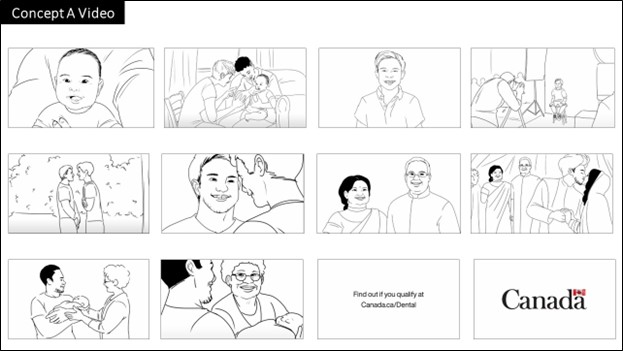


Overall Reaction
The Concept’s message about the introduction of the new dental care plan was overshadowed by the focus on smiles, leading many to confusion or a belief that cosmetic dental care is most important. Concept A’s message was felt to be focused on cosmetic aspects of dental care (i.e., having a perfect smile for photographs), and many indicated that the focus felt inappropriate for a serious topic of what was felt to be a necessary form of healthcare. Further, some felt confused by the message and headline, feeling that the campaign was not clear in what it was communicating. That said, some felt that the light tone and diverse representation offered a positive introduction to the new Canadian Dental Care plan. Despite some negative reactions, many still felt they would seek more information about the Canadian Dental Care Plan after seeing the Concept.
“It’s making light of the situation. It’s happy, upbeat but too light.” – Ontario/General Population
“Smile is the theme, but it dilutes the message to get dental care.” – Prairies/Parents
“The message of the video doesn’t relate to the aim of the ad.” Northern/Western Remote Communities
“Good but obsessed with smiling. Dental problems are deeper than having a nice smile.” – Ontario/Seniors
Overpowering Diversity
Diversity was felt by many to supersede the campaign’s message about dental care. The Concept’s diversity conveyed a sense of inclusivity about the Canadian Dental Care Plan to many. It was felt that by showing different kinds of families, as well as ethnic diversity and various abilities, the campaign conveys that the new program is open to all. That said, there were also several participants across groups who reacted negatively to the Concept’s diversity, feeling that it was too ‘forced’ and strong, becoming the main point of the campaign, rather than focusing on dental care.
“The diversity catches my attention, but the topic is more important to me.” – Eastern Remote Community
“To me, it looks like they tried too hard to show diversity. It’s something I appreciate, and I notice, but it did not appeal to me.” – Atlantic/Seniors
Intriguing Music
The upbeat music grabbed attention. The Concept’s song and cheerfulness / upbeat tone were appreciated by many, who said that the song in the video grabbed their attention. The Concept performed relatively strongly with respect to gaining attention and being memorable. Despite an appreciation for the specific song used in the Concept, participants believed they would still appreciate the video if a different song was used, assuming it remains upbeat, cheerful, and with its content still related to smiles. Conversely, a few found the music off putting and overbearing.
“It is memorable if you are 65 and up and qualify.” – Ontario/Seniors
“The music stuck out as cheery and positive.” – Prairies/Parents
“J’ai aimé la musique, mais je ne m’en rappelle pas. Une musique sans parole serait correcte.” (I liked the music, but I don’t remember it. A song without words would be fine.) – Quebec/General Population
The following provides an overview of reactions specific to Concept B (Tooth Fairy).
Very few resonated with Concept B, as the tooth fairy approach was seen to be too light, confusing or condescending.
Concept B
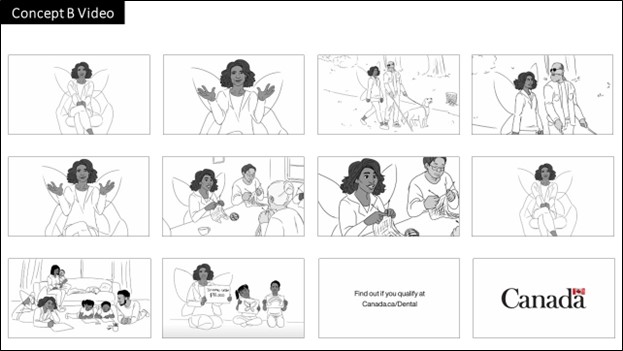
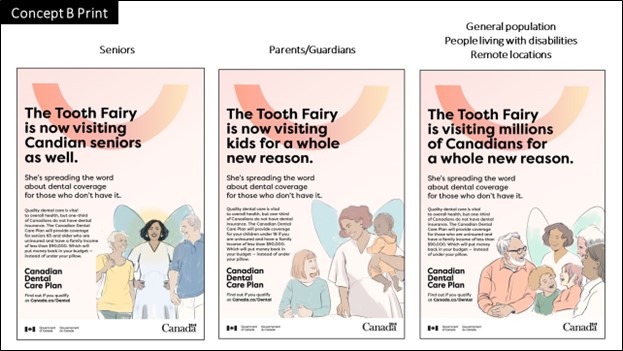
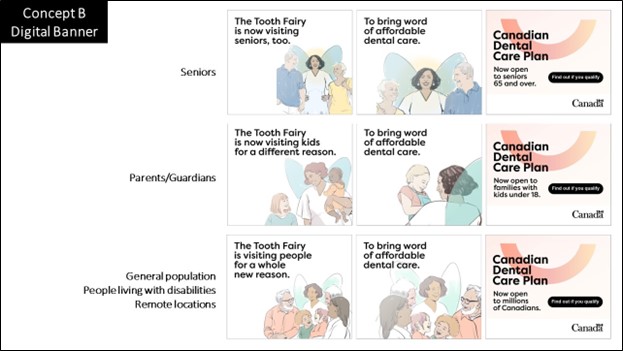
Overall Reaction
The ‘tooth fairy’ approach resonated with only a few, and many found it confusing or offensive. Concept B’s tooth fairy imagery and text was nearly universally not liked across groups, though some parents and other adults felt it would work well for kids (who would then tell their parents about the program). Some participants felt that the Concept was fun, nostalgic, catchy and easy to follow, however, Seniors and those living with disabilities very commonly found this approach condescending and infantilizing. Others mused that if the Concept was being presented by using an imaginary figure, then the program, too, was imaginary.
“It’s like you’re talking to a two-year-old, because of the tooth fairy. It’s patronizing.” – Ontario/General Population
“It grabs your attention, but I am not a fan of the tooth fairy. It felt a bit childish and insulting. I did not relate to it. It grabbed my attention but to criticize it.” – Atlantic/General Population
“I’ve spent most of my career teaching and the tooth fairy is big. It gets that aim towards families. I think they would benefit the most.” – Prairies/Seniors
Clear Message Despite Negative Reactions
Despite strong negative reactions, many still clearly understood the message of the Concept and would seek more information. Even though many participants reacted very negatively towards the Concept, many still felt that they would seek further information and understood the message of the campaign to be about the introduction of a new dental care plan for those without dental insurance and who make under $90K for a family. While the print and digital banner headlines did not clearly state eligibility, the video appeared to provide more clarity.
“Message is good – direct about the program. Informative in a short time about dental benefit.” – Prairies/Parents
“This one made it clear right away that it is about your teeth.” – British Columbia/ General Population
Confusing Target Audience
The Concept’s target audience was confusing to many. The target of the campaign was felt by many to be families, given the resonance and familiarity of the tooth fairy to children. Some seniors, and single adults, felt that they were being infantilized with imagery of a tooth fairy visiting them. Others felt the imagery of a tooth fairy walking in between seniors was reminiscent of an angel walking with older people close to death.
“The first thing that I thought is that it’s not targeting me, and I lost interest quickly. Right away they should tell me if you want to go to the dentist and you can’t afford it.” – Ontario/General Population
“It’s not a senior’s type video. It is a younger generation thing presenting a concept for seniors, so there are disparities there.” – Atlantic/Seniors
“J’ai horreur qu’on m’infantilise. Dans une publicité qui s’adresse aux aînés, qu’on soit sérieux et qu’on s’adresse directement à moi et non aux enfants. Et qu’on m’informe davantage.” (I hate being infantilized. An ad that is aimed at seniors needs to be serious and it needs to speak directly to me and not to children. And give me more information.) – Quebec/Seniors
Not Universally Recognized
Some raised concerns that the tooth fairy may not be universally recognized. Although only a handful of individuals expressed concern themselves, many felt that the tooth fairy was not a cross-cultural symbol that would be understood by all Canadians. A few participants who were new immigrants reinforced this concern in that they were not personally raised with the idea of the tooth fairy.
“Kiddish. Not only that, but using the tooth fair – not sure it’s universal.” – Ontario & Atlantic/People Living with Disabilities
“It grabbed my attention because it triggered me. Thinking of communities/cultures who have no clue what the tooth fairy is. It opens for confusion and questions without telling the story. If you struggle with English or you’re Indigenous – it feels like a barrier instead of opening a door.” – Northern/Western Remote Communities
“J’ai grandi dans une culture ou la fée des dents n’existait pas.” (I grew up in a culture where the tooth fairy does not exist.) – Quebec/General Population
Alternative Fairy Mixed Reactions
The alternative tooth fairy portrayal received mixed reactions. When presented with an alternative version of the tooth fairy character for this concept, participants offered blended feedback. While some liked having a more realistic portrayal of a dental professional, there were still confusion as to the reasons for having the tooth fairy name tag. Others preferred the more magical and iconic portrayal of the tooth fairy in the original concept. Regardless of participants’ preference, the alternative tooth fairy was not considered as improving the overall concept’s appeal.
Concept B Alternative

“Doesn’t look all that different – just no wings.” – Atlantic/Parents
“The first one (fairy) was more annoying but it will stick in my head during the day, and I will remember that dental care is important.” – British Columbia/General Population
“Far better – completely relatable. I’ve spent thousands of dollars on dental care. Looks like a hygienist.” – British Columbia/Seniors
“Ce personnage-là ou l’autre, ça ne fait pas de différence. Je pense que c’est la fée des dents qui enlève le sérieux. Il ne faudrait pas l’appeler la fée des dents; ce n’est pas crédible, c’est imaginaire.” (It doesn't make a difference between this character and the other. I think it's the tooth fairy that takes away from the seriousness. She should not be called the tooth fairy; It's not believable, it's imaginary) – Quebec/General Population
The following provides an overview of reactions specific to Concept C (Simple Facts).
Concept C
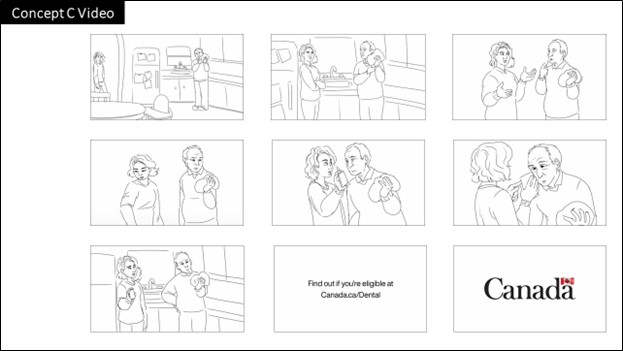
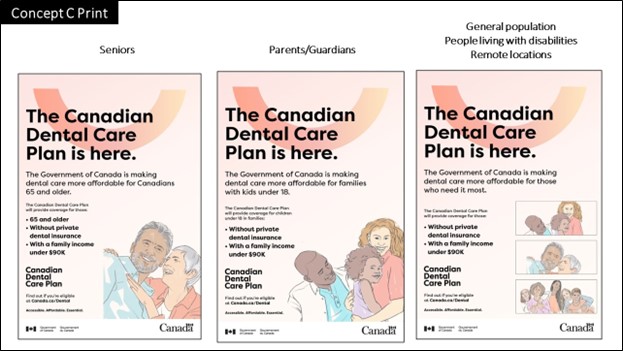

The Simple Facts concept was most preferred among participants, due to its strong message and clarity.
Overall Reaction
Concept C received more preference votes by far, with only a handful believing the other concepts were stronger. Across group types and languages, Concept C was preferred by participants, who cited its strength as being its clarity, relatability, straightforwardness, and factual/informative approach. The Concept’s simplicity in the video, as well as the list of eligible criteria as headlines in the banner ad and in bullet-point format in the print version contributed to the Concept’s perceived simplicity and informative nature. Participants also noted that the Concept addressed dental care in a serious way (by the inclusion of a painful scenario), rather than equating dental care with something that was deemed more frivolous (such as cosmetic care of teeth). The idea was felt to be relatable, particularly among those without insurance.
“It grabbed my attention. Simple and to the point. It tells you what’s going on.” – Atlantic/General Population
“A little humour with the peas but not overly humourous.” – Ontario/Seniors
Tone was well received.
The Concept’s tone and approach were appreciated. Participants noted that the Concept portrayed a realistic and serious scenario whereby a lack of dental coverage results in pain, but that the story was told with a little bit of humour and a positive, hopeful tone. This approach was felt to be a good fit for the topic and introduction of the new dental care plan. Participants generally felt that the Concept would grab their attention (as the scenario is relatable and humorous and the headlines clearly outline eligibility), that they would remember the idea, that the Concept’s message was believable, and importantly, most indicated that they would want to look for information about the Canadian Dental Care plan after seeing these ads.
“More real. More everyday occurrence, a reality commercial. And truthful, affordable and does not lead you to think it’s free.” – Atlantic/General Population
“It did not catch my eye, but it was straight to the point. I can relate to the top part of it. How many people, how often do we have to do that because we don’t have access to dental care? That is relatable.” – Eastern Remote Community
Relatable Concept
The Concept was felt to be relatable by many. The Concept’s video, showcasing the ‘frozen peas’ scenario was nearly universally relatable to participants, who indicated that they could either imagine someone they knew being in that situation (i.e., someone not going to the dentist, despite being in pain, because of not having insurance to cover the cost), or having been in that situation themselves. That said, some caution must be taken to ensure that in the scenario, the individual in pain is not portrayed in a stereotypical way, with the younger person ‘knowing it all’ and the older person being weak and oblivious. Some seniors found that trope to be insulting and condescending that the older person was portrayed in a way that seemed that he didn’t know what was going on.
“It grabbed my attention more than the last one because I make under $90k so I would be able to see this is an ad for me. I would look into it.” – Ontario/General Population
“Less cheesy. Straightforward. The plan is here.” – Northern/Western Remote Communities
“J’ai envie d’en apprendre plus. Le revenu inférieur à 90 000 $ c’est accrocheur. Et pas d’assurance dentaire, c’est moi.” (I want to learn more. Income under $90,000 is eye-catching. And no dental insurance, that's me.) – Francophones/People Living with Disabilities
Following the discussion of each of the three concepts, participants were asked to choose which one is most likely to grab their attention in a positive way and perhaps make them want to find out more about the Canadian Dental Care Plan.
Concept C was most selected for its clear communication of important information.
Concept C (Simple Facts) emerged as the preferred concept across all audiences and groups. As noted, the bulk of participants preferred this concept as the one that would most entice them to seek information, and also indicated it was the clearest at communicating important information about the new dental care program. The video’s relatable scenario and approach of taking a serious situation but presenting it in a gentle and fun way was appreciated by many.
“Concept C is very straightforward and relatable. Not confusing. Would make me want to look further.” – Ontario/Seniors
“It grasped the concept perfectly. It also had great parts. It also gave more in-depth on the target audience of the program and the qualifications.” – Northern/Western Remote Communities
“Il y a les trois conditions tout de suite dans la vidéo et je me reconnais dans le scénario.” (There are the three conditions right away in the video and I recognize myself in the script.") – Quebec/Seniors
“Ça va droit au but. C’est clair. Tous les mots-clés sont là, comme revenu inférieur à 90 000 $ et pas d’assurance dentaire.” (It's straight to the point. It’s clear. All the keywords are there, like income under $90,000 and no dental insurance.) – Quebec/Parents
Concepts A (Smiles) and Concept B (Tooth Fairy) were only selected by a small number across groups. Concept A (Smiles) was most selected for its light, positive, and upbeat approach and for being diverse. Those who chose Concept B (Tooth Fairy) primarily did so because they thought it would resonate with children and families.
Concept A: “I found the other options not as clear. In video A, the message was clear and the music was great.” – Prairies/Parents
Concept B: “Hit me harder – the others make no sense to me.” – Atlantic/Parents
Concept A : “Je me reconnais bien et ça cible les personnes de 65 ans et plus. Les images présentent tout le monde et ça touche tous les éléments de la société. Ça présente la globalité de la vie.” (I recognize myself well and it targets people aged 65 and over. The images present everyone and it touches all elements of society. It presents the totality of life.) – Quebec/Seniors
The following provides broad conclusions from the summary of research findings, for each of the two research phases.
Cost is by far the principal barrier to seeking more regular dental care, even among those who have access to dental insurance. The lack of affordability leads some to avoiding dental care altogether, while others report getting less frequent care. Anxiety is also an important barrier, either based on the fear of pain, or a bad previous experience. Apart from cost, access is most problematic in rural or remote areas, where there is greater wait time to secure dental care. Other less commonly cited barriers include a lack of time, inconvenient business hours, the inability to find a dental office with flexible payment terms, mistrust in the advice of dental professionals, mobility issues, and being embarrassed about the condition of one’s teeth.
Although parents and seniors are generally aware of dental care coverage provided by the provincial or territorial governments for children and seniors, there is minimal awareness of other federal government programs or initiatives to assist with the cost of dental care. Further, the Canada Dental Benefit’s name recall is low. In general, program awareness stems from the Canada Revenue Agency, Service Canada or a dental professional.
A number of graphic elements elicited similar comments across the concepts tested. More specifically, the choice of font was appreciated for being approachable, warm, friendly, and easy to read, and for its casual and inviting vibe. While it is seen as an unconventional choice for government communications, it remains credible and trusted.
In terms of the visuals, the people featured appear a little too ‘perfect’ and the situations shown a little too staged to make any of the concepts relatable. There is a need to show a variety of body-types and facial features, as well as diversity in the types of smiles and dental status. At the same time, the visuals shown in all three concepts are considered generic and not effectively communicating the importance of good dental care. It was suggested to show day-to-day situations demonstrating the importance of dental care (e.g., wearing a mouth guard while playing sports, wearing braces, eating an apple) although referencing only the type of care covered by the Plan.
The three concepts currently show individuals from various backgrounds and demographics suggesting that the Plan is all-inclusive, with a special focus on seniors, children, and visible minorities. As such, middle-aged Caucasian individuals and those without children felt left out and wondered if they were eligible for coverage.
Despite appeal for its simple graphic design and muted tone, this concept lacks strong visual impact and personal relevance. The colour palette is calm and soothing, though the tone is somewhat boring and passive thus not effectively grabbing attention or spurring a sense of excitement. This concept was more often referred to as a ‘typical government piece’ or ‘corporate’ material that could be used by a private insurance company, for example. It was also most commonly labelled as lacking interest and a concept that could easily be overlooked.
Nonetheless, the simple design in Concept A was felt to be pleasing to some, although there are mixed reactions to the graphic elements with some questioning their relevance. The purpose for the background motif isn’t clear and while it contributes to making the approach look more dynamic, it is seen by some as distracting. That said, it is readily associated with a smile.
The choice of visuals is skewed towards visible minorities, thus suggesting a program primarily targeting newcomers. Images are also more family oriented and inclusive of seniors than the other concepts. In general, the concept lacks personal relevance for failing to illustrate more realistic people and situations. That said, having people look directly at the camera is engaging.
Mixed reactions were offered about this concept. The bright, warm, and unusual colour grabbed the attention of some, while others disliked it. Some found the visual components interesting and modern because of the bold graphic elements, while others felt that it made the concept look cluttered and took away the focus from the message. This was further exemplified by the graphic shaped like a smile being positioned on top of images, or cutting into part of the images. Many disliked the graphic representation of the smile in a more structured or defined way than the one used in Concept A, as it was felt to be too rigid and not necessarily suggestive of a smile. The use of statistics and ratios is well liked and draws attention to important information, as long as the information is easy to understand and meaningful.
This concept’s visual held a little more personal relevance than the other two, for showing more realistic and ‘imperfect’ people, some of whom look genuinely happy. There is also a greater diversity of smiles represented.
This concept was felt to be the least visually interesting of all three, primarily due to the low contrast, white background, and muted tones, and for being visually cluttered, despite being described as ‘bright’, ‘airy’, calming and reassuring. The semi-circle graphic was not readily associated with a smile and its purpose was unclear. Further, the way it is used to frame images, and to add visual interest on top of the images is distracting and focused attention on the faces rather than highlighting the situations or interactions featured.
That said, the design gives the impression that more information would be provided, and there is some appeal for the way it is divided in paragraphs or blocks of text. Further, the presence of statistics and pictograms grabbed attention. While this concept speaks to a broad audience, some felt less compelled by it as it focuses on select demographic groups, including seniors and newcomers.
Concept A was most selected for its uncluttered design, its simplicity, the calm colour palette, and simple graphic elements that do not overpower the images. Concept B was preferred for its attention-grabbing and warm colour scheme, dynamic design, and for showing images of people with more genuine smiles. Both held appeal for having visuals of people looking directly at the camera. French-speaking participants preferred Concept C for the appearance of being more informative and for the manner in which the information is presented in paragraphs or blocks of text.
Regardless of the final concept, social media, traditional media (notably television and radio), direct mail, and brochures or posters in health-related public location were seen as the best way to inform the public about the Canadian Dental Care Plan.
Of the seven taglines shown, “Accessible. Affordable. Essential.” was by far the preferred and deemed most effective across groups for addressing the main barriers to seeking dental care. That said, it is a strong promise that creates high expectations about the plan. The tagline “Dental care you can depend on” was also liked for the reassurance it provides.
Consistent with findings from phase one, financial considerations are the most significant limitation to visiting the dentist. Anxiety, pain, previous bad experiences, distance, and lack of time are also important factors that limit regular dental care visits. Those in rural areas tend to express cost in conjunction with distance, as many must travel hours to see a dentist. Further, those living with disabilities also note accessibility issues in dentist offices and reason why they don’t seek more regular checkups.
There was limited awareness among participants of government programs related to dental care, and even those who were previously aware, knew hardly anything about the programs themselves. Some parents indicated they knew of programs for their young children, and some noted that Canada Revenue Agency was the source for this information. Various provincial or territorial programs were also brought up by some. While a small number of participants had heard of the Government of Canada’s intentions to offer dental coverage, most were not privy to the details of the program.
It was most important for participants that the concept be clear in what it’s trying to communicate and noticeably appeal to its target audience. While audiences want simple messages, it was also felt that there were some confusing elements, such as the term ‘family’ income vs. household income.
The tagline ‘Accessible. Affordable. Essential.’ continues to be largely well-received across participants. While there is still a desire for further information, participants stated that their preferred concept would motivate them to seek out the answers to their questions.
Concept A delivered a message that was felt to be inappropriate for such a serious subject matter. It was also felt that the concept lacked clarity on what it was trying to communicate. Some participants suggested that the focus on ‘smiles’ was off-putting, as the cosmetic side of dental care is not the most important. Conversely, this concept had some praise for its inclusivity and lighter tone. Despite some negative reactions, many still felt the concept would motivate them to look for more information about the Canadian Dental Care Plan.
Concept B elicited mostly negative reviews as it was found to be confusing, silly and mentions that the tooth fairy is not necessarily a universally well-known concept. Some parents enjoyed it for its nostalgia and being easy to follow. That said, its lack of seriousness caused problems with many. Seniors and those living with disabilities also found this approach to be condescending and infantilizing.
This alternative tooth fairy portrayal also received mixed review from participants. While some enjoyed the more realistic depiction of a dental professional, the tooth fairy name tag presented some confusion. Others still supported the more magical fairy portrayal of the tooth fairy. Either option did not improve the overall review of the concept.
Concept C was widely chosen as the preferred concept, mostly because it would motivate people to seek further information and clearly communicated important information about the new program. Many found the ‘frozen peas’ scenario to be relatable, with a little bit of humour. The target audience was also seen to be more ‘age inclusive’ compared to the other two concepts shown. It was appreciated that the focus was on the health aspect of dental care, rather than the cosmetic side.
Concept A was selected by some for its light, positive and upbeat approach, as well as its diversity and wide-scale representation of Canadian residents. Concept A was also praised by some for being straightforward and to the point. Concept B was chosen by few for its potential to resonate with children and families, as well as its fun visuals. Perhaps unsurprisingly, across participant groups, parents were more likely to choose Concept B as their preference.
Regardless of the final concept, social media, traditional media (notably television and radio), direct mail, and brochures or posters in health-related public location were seen as the best way to inform the public about the Canadian Dental Care Plan.
As it moves to finalize the development of its campaign, Health Canada should consider the following:
The analysis of findings from the first phase of the study suggests that the following should be considered in the development of the campaign’s look and feel.
Combining elements of both concepts would provide a stronger visual brand for the Canadian Dental Care Plan. Most notably, the final concept should consider the following elements:
Given that affordability is the greatest barrier to accessing dental care, and that it is the main promise of the Canadian Dental Care Plan, the tagline “Accessible. Affordable. Essential.” should be considered. That said, care must be taken to ensure that the promise can be realized, notably in terms of accessibility.
The analysis of findings from the second phase of the study suggests that the following should be considered in the development of the campaign’s creative material.
Health Canada: Canadian Dental Care Plan Focus Testing Recruitment Screener: Phase 1 – Final
Name:______________________________________________________________________________
Home phone: ________________ Work phone:___________________ Cell: ____________________
Email: ______________________________________________________________________________
Community: ____________________________ Province/Territory: ______________________________
| Date (2023) | Group | AST | EST | Participant Time | Audience | Language | Moderator |
|---|---|---|---|---|---|---|---|
| Tuesday, July 11 | 1 | 6:00PM | 5:00PM | 6:30PM/6:00PM | Atlantic | EN | CP |
| 2 | 8:30PM | 7:30PM | 6:30PM/5:30PM | Prairies/NWT/NU | EN | CP | |
| Wednesday, July 12 | 3 | 7:00PM | 6:00PM | 6:00PM | Ontario | EN | CP |
| 4 | 9:30PM | 8:30PM | 5:30PM | BC/Yukon | EN | CP | |
| Thursday, July 13 | 5 | 6:30PM | 5:30PM | 5:30PM | Quebec | FR | CP |
|
|
| Audience | Atlantic (English) | Ontario (English) | Prairies/ NWT/NU (English) | BC/Yukon (English) | Quebec (French) | Total Groups | Total Recruits |
|---|---|---|---|---|---|---|---|
| General Population 18+ (mix from target audiences identified above) | 1 | 1 | 1 | 1 | 1 | 5 | 50 |
| TOTAL | 1 | 1 | 1 | 1 | 1 | 5 | 50 |
RECRUITER NOTE - WHEN TERMINATING AN INTERVIEW, SAY: “Thank you very much for your cooperation. We are unable to invite you to participate because we have enough participants who have a similar profile to yours.”
RECRUITER NOTE: If a respondent wishes to verify the validity of the study, please contact:
Government of Canada: 1-800-926-9105; questions@tpsgc-pwgsc.gc.ca
Narrative Research: 888-272-6777; focusgroups@narrativeresearch.ca
Hello, my name is _______________ and I am calling on behalf of Narrative Research, a national market research company. Would you prefer that I continue in English or French? / Préférez-vous continuer en français ou anglais?
RECRUITER NOTE - FOR ENGLISH GROUPS, IF PARTICIPANT WOULD PREFER TO CONTINUE IN FRENCH, PLEASE RESPOND WITH: "J’appelle aujourd’hui concernant les groupes de discussion qui se tiendront en anglais. Désirez-vous qu’un collègue vous rappelle afin de vous inviter à participer à un groupe de discussion qui aura lieu en français?"IF YES, ARRANGE CALL BACK
Let me assure you that we are not trying to sell you anything. We are conducting a public opinion research project for the Government of Canada, and we are looking for people to take part in a 2-hour online focus group that will be scheduled from <INSERT DATE> to <INSERT DATE>. Participants will receive a financial incentive if they qualify to take part. Is this something you might be interested in?
The purpose of this group discussion is to hear people’s opinions on communications materials being developed by the Government of Canada. Your participation is voluntary, anonymous and confidential. No attempt will be made to sell you anything or change your point of view.
[IF ONLINE, PROVIDE A LINK TO NARRATIVE RESEARCH’S PRIVACY POLICY AT THE BOTTOM OF EACH PAGE: https://narrativeresearch.ca/privacy-policy/#politique-de-confidentialit%C3%A9]
[IF BY PHONE: Narrative Research’s privacy policy is available upon request. IF ASKED, PROVIDE PRIVACY POLICY LINK BY PHONE OR RECORD EMAIL WHERE IT WILL BE SENT]
This research is registered with the Canadian Research Insights Council Research Verification Service. [IF NEEDED, SPECIFY: to verify the research, you can visit canadianresearchinsightscouncil.ca/rvs/home/?lang=en. The survey registration number is 20230620-NA421]
The format of the focus group is an informal small online group discussion led by a professional moderator. May I ask you a few quick questions to see if you are the type of participant we are looking for? This should take about 7 or 8 minutes.
To begin, do you or any member of your household currently work in or has retired from…? [SHOW RESPONSES – RANDOMIZE – CODE ALL THAT APPLY]
INSTRUCTIONS: If yes to any of the above, thank & terminate
In which community and province or territory do you currently live?
INSTRUCTIONS: Recruit mix of provinces/territories and communities in each group
Are you a parent or guardian of a child aged 17 or under?
INSTRUCTIONS: Recruit 2-3 per group who say “Yes” (Code 1) (PARENTS)
Do you [PARENTS: or your children] have: [SELECT ONE ONLY]
INSTRUCTIONS: Recruit 7 per group who say “Public” or “none” (Code 2 or 4) and 3 per group who say “private” or “both” (Code 1 or 3). If unsure/prefer not to answer, thank & terminate
Into which age group are you? Stop me when I reach your age group. Are you…? [SHOW RESPONSES IN ORDER]
INSTRUCTIONS: If less than 18 (Code 1) Thank & Terminate. Aim for a mix. Recruit 2-3 per group who are 65+ (code 7, 8 or 9) (SENIORS)
Are you [READ]?
INSTRUCTIONS: Recruit mix
Are you a person living with a disability or impairment?
INSTRUCTIONS: If “no” or “prefer not to answer”, skip to QP10; if “yes” continue
Do you have a T2201 Disability Tax Credit Certification on file with the Canada Revenue Agency?
Which of the following impairments do you experience or live with? Please choose all that apply. [SHOW RESPONSES IN ORDER]
INSTRUCTIONS: Recruit 2-3 per group who say “Yes” at Q.P7 (Code 1), “yes” at P8 and at least one of the disabilities/impairments at Q.P9 (DISABILITIES)
What is your current employment status? [SHOW RESPONSES IN ORDER]
What was your household’s total income last year? That is, the total income of all persons in your household combined, before taxes? Note that this information will remain confidential. [SHOW RESPONSES IN ORDER]
INSTRUCTIONS: If “$90,000 or more” (Code 6) or “Unsure/Prefer not to answer” (Code 7) thank & terminate
What is the highest level of education that you have completed? [SHOW RESPONSES IN ORDER]
To make sure that we speak to a diversity of people, could you tell me what is your ethnic background? [MULTIPLE RESPONSES KEEPING CODE 9 EXCLUSIVE]
INSTRUCTIONS: Recruit good mix of ethnic background and good representation of racialized communities
Approximately how far is the nearest dental professional (dentist, hygienist, etc.) from your home? Would you say….
INSTRUCTIONS: Recruit 2-3 per who say “At least three hours drive away or 350 kms away” (Code 3) (REMOTE)
The focus groups for this project will be conducted online on the Zoom platform and will require the use of a laptop or desktop computer, or a computer tablet, connected to high-speed Internet and equipped with a webcam, a microphone and speakers. Note that because of the complexity of the material we are showing on the screen during the focus group, you cannot use a smartphone to access the online session. The screen of those electronics is simply too small for the purpose of this research project.
Do you have access to a laptop or desktop computer, or a computer tablet, with high-speed Internet to take part in this focus group? [MULTIPLE RESPONSES KEEPING CODE 3 EXCLUSIVE]
INSTRUCTIONS: If no, thank & terminate
Is the computer or tablet you will use for the focus group equipped with a webcam, a microphone and speakers you will be able to use?
INSTRUCTIONS: If no, thank & terminate BUT WEBCAM OPTIONAL FOR REMOTE PARTICIPANTS
You will need to be in a place that is quiet and free of distractions for the duration of the session. This includes being on your own, without pets, children or other people nearby, and in a quiet room. An outdoor area, a vehicle, or a public place are NOT acceptable locations. Are you able to secure a quiet environment without distractions or noises for the duration of the focus group session?
INSTRUCTIONS: If no, thank & terminate
INSTRUCTIONS FOR NF1-NF3 THANK & TERMINATE: Based on your responses, we are unable to invite you to take part in this online focus group, as you do not meet the technical or logistic requirements. We thank you for your interest in this research.
I just have a few more questions…
Have you ever attended a group discussion or interview for which you received a sum of money?
INSTRUCTIONS: Max 4 recruits per group who answered “yes”. If “yes” continue. If “no”, go to SECTION I: Invitation
When was the last time you attended a group discussion or interview? _____________
How many groups or interviews have you attended in the past 5 years? ____________ MAX 4
What was the subject(s) of the focus group(s) or interview? __________________________
THANK AND TERMINATE IF THEY HAVE…
Based on your responses so far, we would like to invite you to participate in a small group discussion that will be conducted online at <INSERT TIME> on <INSERT DATE>. The session will bring together 8 to 10 people and it will last up to 2 hours. We will send you a link to join the online focus group via Zoom and during the session, you will provide feedback on communication materials currently being developed by the Government of Canada. In appreciation for your time to attend the focus group, you will receive $125after the session.
INSTRUCTIONS: If no, thank & terminate
INSTRUCTIONS: If no, thank & terminate
INSTRUCTIONS: Must answer French (code 2) for Quebec groups
INSTRUCTIONS: If “no” or Unsure, thank & terminate
Could we please confirm the email address where we can send you the instructions to log in to the focus group session?
Record email address (and verify): ________________________________________________.
We will send you by email the log-in instructions at least 1 day in advance of the group. The group discussion will begin promptly at <TIME> and will last up to 2 hours. Please log in on time to ensure that the session is not delayed. If you arrive late, we will not be able to include you in the discussion and will not provide you with the incentive.
As mentioned, we will be pleased to provide everyone who participates with $125, provided by e-Transfer or cheque, as you’d prefer. It takes approximately 5 business days to receive an incentive by e-Transfer or approximately 2-3 weeks following your participation to receive an incentive by cheque.
Email address:________________________________________________________________
And please confirm the spelling of your name: _______________________________________
The e-transfer password will be provided to you via email following the group.
Mailing address:_______________________________________________________________
City: ________________________________________________________________________
Province: ____________________________________Postal Code: _____________________
And please confirm the spelling of your name: _______________________________________
So that we can call you to remind you about the focus group or contact you should there be any last-minute changes, can you please confirm your name and contact information for me? [CONFIRM INFORMATION ALREADY COLLECTED AND CHANGE/COMPLETE AS NECESSARY]
First Name: ____________________________________________
Last Name: ____________________________________________
Email: ________________________________________________
Cell Phone: ____________________________________________
Home Phone: __________________________________________
Work Phone: ___________________________________________
INSTRUCTIONS: If the respondent refuses to give his/her first or last name or phone number please assure them that this information will be kept strictly confidential in accordance with the privacy law and that it is used strictly to contact them to confirm their attendance and to inform them of any changes to the focus group. If they still refuse THANK & TERMINATE.
Thank you for your interest in our study. We look forward to hearing your thoughts and opinions!
Attention Recruiters
Confirming – DAY BEFORE GROUP
Health Canada: Canadian Dental Care Plan Focus Testing Recruitment Screener: Phase 2 – Final
Name:______________________________________________________________________________
Home phone: ________________ Work phone:___________________ Cell: ____________________
Email: ______________________________________________________________________________
Community: __________________________ Province/Territory: ______________________________
| Date (2023) | Group | AST | EST | Participant Time | Audience | Language | Moderator |
|---|---|---|---|---|---|---|---|
| Thursday, October 12 | 1 | 3:00PM | 2:00PM | 2:00PM | Ontario Seniors | EN | MC |
| 2 | 6:00PM | 5:00PM | 2:00PM | BC Seniors | EN | MC | |
| 3 | 7:00PM | 6:00PM | 7:30PM/7:00PM | Atlantic General Population | EN | CP | |
| 4 | 8:30PM | 7:30PM | 6:30PM/5:30PM | Prairies Parents | EN | MC | |
| 5 | 9:30PM | 8:30PM | 5:30PM | BC General Population | EN | CP | |
| Friday, October 13 | 6 | 11:00AM | 10:00AM | 10:00AM | Quebec Seniors | FR | CP |
| 7 | 2:00PM | 1:00PM | 2:30PM/2:00PM | Atlantic Seniors | EN | CP | |
| Monday, October 16 | 8 | 5:30PM | 4:30PM | 6:00PM/5:30PM | Atlantic Parents | EN | MC |
| 9 | 6:30PM | 5:30PM | 5:30PM | Ontario General Population | EN | CP | |
| 10 | 8:00PM | 7:00PM | 7:00PM | Ontario Parents | EN | MC | |
| 11 | 9:00PM | 8:00PM | 7:00PM/6:00PM | Prairies General Population | EN | CP | |
| Tuesday, October 17 | 12 | 6:30PM | 5:30PM | 5:30PM | Quebec General Population | FR | CP |
| 13 | 7:00PM | 6:00PM | 7:30PM/7:00PM/6:00PM | East/North Remote Communities | EN | MC | |
| 14 | 8:30PM | 7:30PM | 7:30PM | Quebec Parents | FR | CP | |
| 15 | 9:30PM | 8:30PM | 5:30PM | BC Parents | EN | MC | |
| Wednesday, October 18 | 16 | 6:00PM | 5:00PM | 6:00PM/5:00PM | Quebec/Atlantic People Living with a Disability | FR | CP |
| 17 | 7:00PM | 6:00PM | 7:30PM/7:00PM/6:00PM | Ontario/Atlantic People Living with a Disability | EN | MC | |
| 18 | 9:30PM | 8:30PM | 7:30PM/6:30PM/5:30PM | West/North Remote Communities | EN | MC | |
| Thursday, October 19 | 19 | 4:00PM | 3:00PM | 2:00PM/1:00PM | Prairies Seniors | EN | MC |
| 20 | 7:30PM | 6:30PM | 5:30PM/4:30PM/3:30PM | West (BC, AB, SK, MB) People Living with a Disability | EN | MC |
|
|
| Target Audience (HHI of <$90,000) | Atlantic (English) | Ontario (English) | Prairies (English) | BC (English) | Quebec (French) | Total Groups | Total Recruits |
|---|---|---|---|---|---|---|---|
| General Population | 1 | 1 | 1 | 1 | 1 | 5 | 50 |
| Parents | 1 | 1 | 1 | 1 | 1 | 5 | 50 |
| Seniors | 1 | 1 | 1 | 1 | 1 | 5 | 50 |
| TOTAL | 3 | 3 | 3 | 3 | 3 | 15 | 150 |
| Target Audience (HHI of <$90,000) | West (English) | Ontario/Atlantic (English) | Quebec/Atlantic (French) | Total Groups | Total Recruits |
|---|---|---|---|---|---|
| People experiencing disabilities | 1 | 1 | 1 | 3 | 30 |
| TOTAL | 1 | 1 | 1 | 3 | 30 |
| Target Audience (HHI of <$90,000) | Territories/Northern regions of provinces (English) | Total Groups | Total Recruits |
|---|---|---|---|
| People residing in remote communities | 2 | 2 | 20 |
| TOTAL | 2 | 2 | 20 |
RECRUITER NOTE - WHEN TERMINATING AN INTERVIEW, SAY: “Thank you very much for your cooperation. We are unable to invite you to participate because we have enough participants who have a similar profile to yours.”
RECRUITER NOTE: If a respondent wishes to verify the validity of the study, please contact:
Government of Canada: 1-800-926-9105; questions@tpsgc-pwgsc.gc.ca
Narrative Research: 888-272-6777; focusgroups@narrativeresearch.ca
Hello, my name is _______________ and I am calling on behalf of Narrative Research, a national market research company. Would you prefer that I continue in English or French? / Préférez-vous continuer en français ou anglais?
RECRUITER NOTE - FOR ENGLISH GROUPS, IF PARTICIPANT WOULD PREFER TO CONTINUE IN FRENCH, PLEASE RESPOND WITH: "J’appelle aujourd’hui concernant les groupes de discussion qui se tiendront en anglais. Désirez-vous qu’un collègue vous rappelle afin de vous inviter à participer à un groupe de discussion qui aura lieu en français?" IF YES, ARRANGE CALL BACK
Let me assure you that we are not trying to sell you anything. We are conducting a public opinion research project for the Government of Canada, and we are looking for people to take part in a 2-hour online focus group that will be scheduled from <INSERT DATE> to <INSERT DATE>. Participants will receive a financial incentive if they qualify to take part. Is this something you might be interested in?
The purpose of this group discussion is to hear people’s opinions on communications materials being developed by the Government of Canada. Your participation is voluntary, anonymous and confidential. No attempt will be made to sell you anything or change your point of view.
[IF ONLINE, PROVIDE A LINK TO NARRATIVE RESEARCH’S PRIVACY POLICY AT THE BOTTOM OF EACH PAGE: https://narrativeresearch.ca/privacy-policy/#politique-de-confidentialit%C3%A9 ]
[IF BY PHONE: Narrative Research’s privacy policy is available upon request. IF ASKED, PROVIDE PRIVACY POLICY LINK BY PHONE OR RECORD EMAIL WHERE IT WILL BE SENT]
This research is registered with the Canadian Research Insights Council Research Verification Service.
[IF NEEDED, SPECIFY: to verify the research, you can visit https://canadianresearchinsightscouncil.ca/rvs/home/?lang=en
The survey registration number is: 20230906-NA135
The format of the focus group is an informal small online group discussion led by a professional moderator. May I ask you a few quick questions to see if you are the type of participant we are looking for? This should take about 7 or 8 minutes.
INSTRUCTIONS: If yes to any of the above, thank & terminate
INSTRUCTIONS: Recruit mix of provinces/territories and communities in each group
INSTRUCTIONS: If “YES” consider for PARENTS groups
INSTRUCTIONS: Recruit 7 per group who say “Public” or “none” (Code 2 or 4) and 3 per group who say “private” or “both” (Code 1 or 3). If unsure/prefer not to answer, thank & terminate
INSTRUCTIONS: If less than 18 (Code 1) Thank & Terminate. If 65+ (code 7, 8 or 9), consider for SENIORS groups
INSTRUCTIONS: Recruit mix in each group
INSTRUCTIONS: If “no” or “prefer not to answer”, skip to QP10; if “yes” continue
INSTRUCTIONS: If “Yes” at Q.P7 (Code 1), “yes” at P8 and at least one of the disabilities/impairments at Q.P9, consider for DISABILITIES groups
INSTRUCTIONS: If “$90,000 or more” (Code 6) or “Unsure/Prefer not to answer” (Code 7) thank & terminate
INSTRUCTIONS: Recruit good mix of ethnic background and good representation of racialized communities in each group
INSTRUCTIONS: Consider for REMOTE groups if travelling more than 100km (code 2 or 3 in P14) and/or no permanent clinics in community (code 2 or 3 in P15).
The focus groups for this project will be conducted online on the Zoom platform and will require the use of a laptop or desktop computer, or a computer tablet, connected to high-speed Internet and equipped with a webcam, a microphone and speakers. Note that because of the complexity of the material we are showing on the screen during the focus group, you cannot use a smartphone to access the online session. The screen of those electronics is simply too small for the purpose of this research project.
INSTRUCTIONS: If no, thank & terminate
INSTRUCTIONS: If no, thank & terminate BUT WEBCAM OPTIONAL FOR REMOTE PARTICIPANTS
INSTRUCTIONS: If no, thank & terminate
INSTRUCTIONS FOR NF1-NF3 THANK & TERMINATE: Based on your responses, we are unable to invite you to take part in this online focus group, as you do not meet the technical or logistic requirements. We thank you for your interest in this research.
I just have a few more questions…
INSTRUCTIONS: Max 4 recruits per group who answered “yes”. If “yes” continue. If “no”, go to SECTION I: Invitation
THANK AND TERMINATE IF THEY HAVE…
- been to 5 or more groups in the past 5 years (max 4 groups/interviews attended)
- attended a focus group in the past six months.
- ever attended a group discussion on advertising and communications materials
Based on your responses so far, we would like to invite you to participate in a small group discussion that will be conducted online at <INSERT TIME> on <INSERT DATE>. The session will bring together 8 to 10 people and it will last up to 2 hours. We will send you a link to join the online focus group via Zoom and during the session, you will provide feedback on communication materials currently being developed by the Government of Canada. In appreciation for your time to attend the focus group, you will receive $125 after the session.
INSTRUCTIONS: If no, thank & terminate
INSTRUCTIONS: If no, thank & terminate
INSTRUCTIONS: If no, thank & terminate
INSTRUCTIONS: Must answer French (code 2) for Quebec groups
INSTRUCTIONS: If “no” or Unsure, thank & terminate
Could we please confirm the email address where we can send you the instructions to log in to the focus group session?
Record email address (and verify): ________________________________________________.
We will send you by email the log-in instructions at least 1 day in advance of the group. The group discussion will begin promptly at <TIME> and will last up to 2 hours. Please log in on time to ensure that the session is not delayed. If you arrive late, we will not be able to include you in the discussion and will not provide you with the incentive.
As mentioned, we will be pleased to provide everyone who participates with $125, provided by e-Transfer or cheque, as you’d prefer. It takes approximately 5 business days to receive an incentive by e-Transfer or approximately 2-3 weeks following your participation to receive an incentive by cheque.
Email address:________________________________________________________________
And please confirm the spelling of your name: _______________________________________
The e-transfer password will be provided to you via email following the group.
Mailing address:_______________________________________________________________
City: ________________________________________________________________________
Province: ____________________________________Postal Code: _____________________
And please confirm the spelling of your name: _______________________________________
So that we can call you to remind you about the focus group or contact you should there be any last-minute changes, can you please confirm your name and contact information for me? [CONFIRM INFORMATION ALREADY COLLECTED AND CHANGE/COMPLETE AS NECESSARY]
First Name: ____________________________________________
Last Name: ____________________________________________
Email: ________________________________________________
Cell Phone: ____________________________________________
Home Phone: __________________________________________
Work Phone: ___________________________________________
INSTRUCTIONS: If the respondent refuses to give his/her first or last name or phone number please assure them that this information will be kept strictly confidential in accordance with the privacy law and that it is used strictly to contact them to confirm their attendance and to inform them of any changes to the focus group. If they still refuse THANK & TERMINATE.
Thank you for your interest in our study. We look forward to hearing your thoughts and opinions!
Attention Recruiters
Confirming – DAY BEFORE GROUP
Health Canada:
Canadian Dental Care Plan Focus Testing (HC POR 23-02)
Moderator’s Guide – Final (July 11)
Study Goals (Confidential – Not read to participants)
Introduction – 10 minutes
Dental Care – 10 minutes
What we will look at today relates to a federal government program that provides financial assistance for dental care. Before we look at the materials, I’d like to learn a bit more about your choices related to dental care, either for yourself, or for others in your household. This is just to provide me with a bit of context given that everyone’s situation might be different – there are no right or wrong answers. First, take a moment to answer a few poll questions individually. Note that we will not discuss your responses as a group.
[POLL - SITUATION]
Discuss, as a group, following the exercise:
Creative Testing – 50 minutes [15 min per concept]
As you may or may not already know, the federal government plans to start rolling out a new national dental program later this year, that will be expanded over the next few years. It’s called the Canadian Dental Care Plan, and will be available for Canadians with a household income of less than $90,000 a year and no access to private dental insurance. They will need communication materials – things like ads, brochures, websites, etc. - to inform the public about this new initiative once it becomes available. The first step is to choose a ‘look and feel’ for those communications materials that conveys the right tone and that is relevant to people. Today, we will look at three concepts, one at a time.
Because further details on the program aren’t yet available, we will focus only on the graphic elements – images, icons, shapes, colours, and text fonts (or lettering style), things like that. Other than the name of the program – the Canadian Dental Care Plan – the words you will see are gibberish – it’s not a real language, and it is only there to show you the visual impact of the text once it is included. So, we will be evaluating the imagery and ‘feel’ of the concepts rather than the written messages.
We will look and discuss each concept one at a time. Hold your thoughts as I show you the materials. Once I am done, I will ask for your individual opinion before we discuss the concept as a group. Please pay attention to the visual components, but also to how it makes you feel, as we will be discussing and focusing on those aspects. MODERATOR PRESENTS EACH CONCEPT ONE AT A TIME – ROTATE ORDER OF CONCEPTS ACROSS GROUPS
| Concepts | Atlantic | Prairies/NWT/NU | Ontario | BC/Yukon | Quebec |
|---|---|---|---|---|---|
| Concept 1 (A): purple shade Concept 2 (B): curved design Concept 3 (C): abstract smile |
G1: A-B-C | G2: B-A-C | G3: C-A-B | G4: C-B-A | G5: A-C-B |
AFTER THE PRESENTATION OF THE CONCEPT: Before we talk about this idea, take a moment to answer, each on your own, the questions you see on the screen. Keep in mind, I can see your responses, but other participants will not.
[POLL –CONCEPT A-C]
Discuss, as a group, following the exercise:
Let’s have a look at the next concept. REPEAT POLL/DISCUSSION FOR THE OTHER CONCEPTS
Final Choice – 10 minutes
Now that we’ve seen all five concepts, I’d like to know which one you think is the strongest. Take a moment to complete a poll:
[POLL – PREFERRENCE]
Discuss, as a group, following the exercise:
Key Messaging – 10 minutes
For the last part of our discussion, I’d like to get your reactions on several statements that could be used on the ads we just saw. There are seven statements – shown on the screen - and we will look at them together. These could be used as headlines in advertisements when speaking of the Canadian Dental Care Plan, or as a tagline. MOERATOR READS THE TAGLINES OUTLOUD
Before we discuss your reactions, please answer a few poll questions:
[POLL – MESSAGING]
Discuss, as a group, following the exercise:
Thanks & Closure:
That’s all my questions; thank you for taking part in our discussion. We will follow up with you by email regarding the incentive. Note that once finalized, the study report for this project will be available to the public through a government agency called Library and Archives Canada.
What we will look at today relates to a federal government program that provides dental coverage for Canadians. Before we look at the materials, I’d like to learn a bit more about your choices related to dental care, either for yourself, or for others in your household. This is just to provide me with a bit of context given that everyone’s situation might be different – there are no right or wrong answers. First, take a moment to answer a few poll questions individually. Note that we will not discuss your responses as a group.
[POLL - SITUATION]
Discuss, as a group, following the exercise:
Today, we will look at three ideas for an advertising campaign being developed by the Government of Canada about a dental care plan. Each concept includes one video, one print ad, and one digital banner ad you could see online.
The ads are still in development, and they have not yet been produced. As I am showing you the concepts, you will have to envision what the final ads would look like once they are professionally produced. For example, the video I am showing you consists of a series of still drawings with a recording describing the scenes and explaining the dialogues or spoken words. But, the final video would be professionally produced and feature live action and professional talents. For the print and online ads, what I will show you uses sketches but the final ads would show photography with real people. The photos you see today are there to give you a general sense of the look and feel of the ads, but these would not be used in the final ads.
We will look and discuss each concept one at a time. Hold your thoughts as I show you the materials. Once I am done, I will ask for your individual opinion before we discuss the concept as a group. Please pay attention to both the message and how it is communicated, as we will be discussing and focusing on those aspects. MODERATOR PRESENTS EACH CONCEPT ONE AT A TIME – ROTATE ORDER OF CONCEPTS ACROSS GROUPS
Concept A: Smiles (DO NOT PROVIDE NAME OF CONCEPTS TO PARTICIPANTS)
[FOR GROUPS 3, 5, 9, 11, 12, 13, 16, 17, 18, 20: GEN POP, PWD, REMOTE] For digital banner execution, describe the scenes depicted in each frame when presenting to the group.
Concept B: Tooth Fairy
[FOR ALL GROUPS] When presenting the animatics, provide additional context to the participants that this tooth fairy would be very fairy-like so that they can visual this (ie. wand, sparkles, etc.) Concept C: Simple Facts
Concept Presentation Order
| Audience | Atlantic | Ontario | Prairies | BC | Francophones | |
|---|---|---|---|---|---|---|
| General Population | G3: A-B-C | G9: B-C-A | G11: C-A-B | G5: A-B-C | G12: B-C-A | |
| Seniors | G7: C-A-B | G1: A-B-C | G19: B-C-A | G2: C-A-B | G6: A-B-C | |
| Parents | G8: B-C-A | G10: C-A-B | G4: A-B-C | G15: B-C-A | G14: C-A-B | |
| Audience | Atlantic/Ontario | West | Francophones | |||
| People experiencing disabilities | G17: B-C-A | G20: A-B-C | G16: C-A-B | |||
| Audience | East/North | West/North | ||||
| People residing in remote communities | G13: A-B-C | G18: B-C-A | ||||
AFTER THE PRESENTATION OF THE CONCEPT: Before we talk about this idea, take a moment to answer, each on your own, the questions you see on the screen. Keep in mind, I can see your responses, but other participants will not.
[POLL –CONCEPT A-C]
Indicate on a 1-10 scale the extent to which the statement aligns with what you think of this concept (where 1 means “no, not at all” and 10 means “yes, absolutely”):
Then write a short response to answer the following question:
[MESSAGE CLARITY] Q5. What is the main message you receive from the concept as a whole?
Discuss, as a group, following the exercise:
[CONCEPT A] Probe participants with this additional question:
[CONCEPT B –ALTERNATE CONCEPT] I’d like to show you an alternate version of the tooth fairy character. [CONTEXT: This is to gauge what participants think of the more casual approach without comparing with the original fairy]
Let’s have a look at the next concept. REPEAT POLL/DISCUSSION FOR THE OTHER CONCEPTS
Now that we’ve seen all three concepts, I’d like to know which one you think is the strongest. Take a moment to complete a poll:
[POLL – PREFERRENCE]
Discuss, as a group, following the exercise:
That’s all my questions; thank you for taking part in our discussion. We will follow up with you by email regarding the incentive. Note that once finalized, the study report for this project will be available to the public through a government agency called Library and Archives Canada.


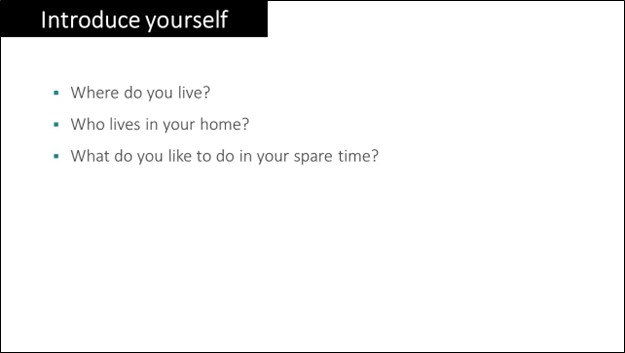

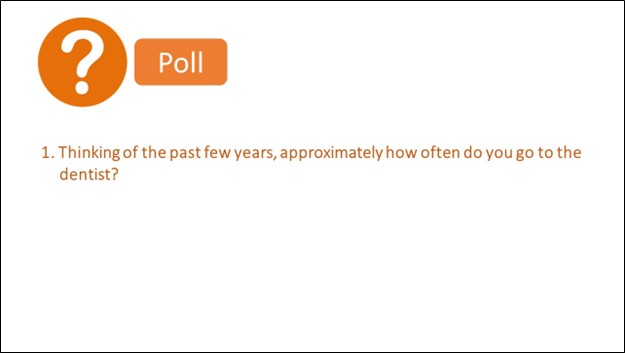

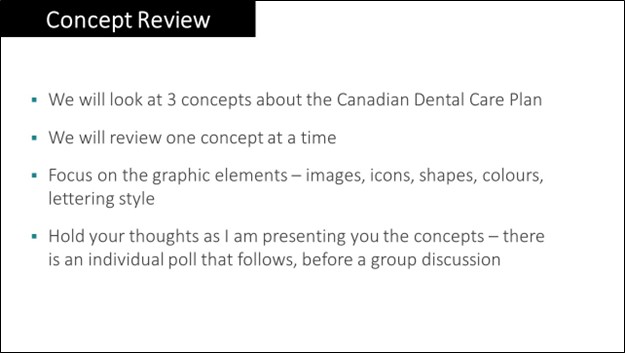
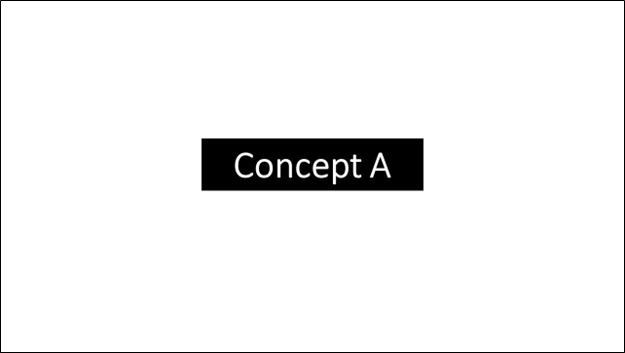

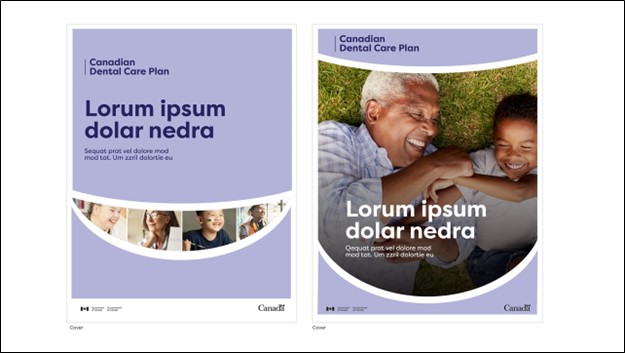
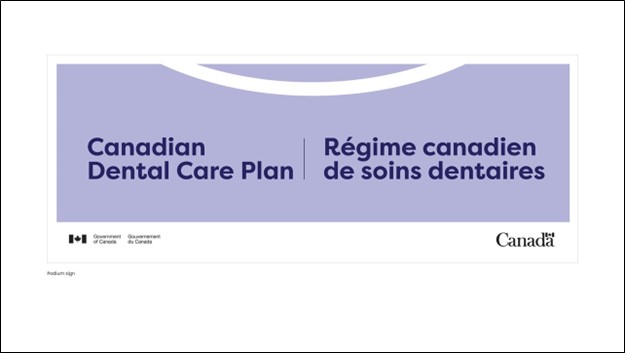
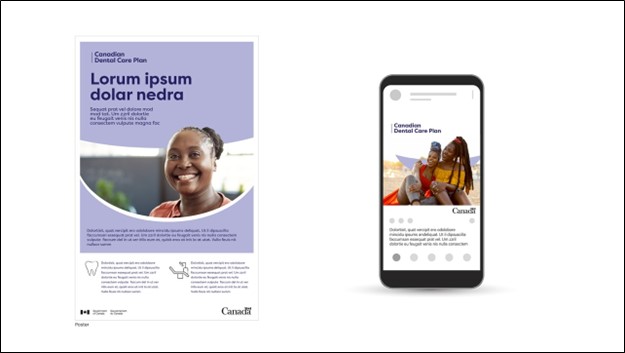




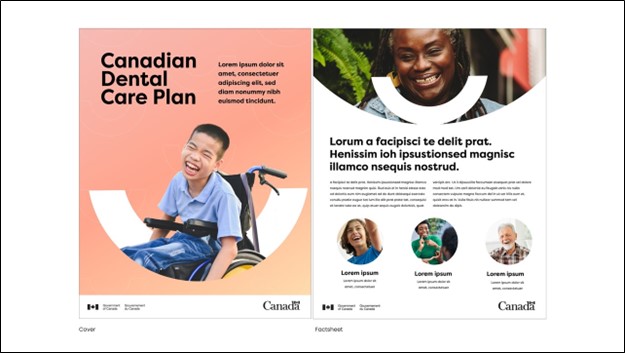
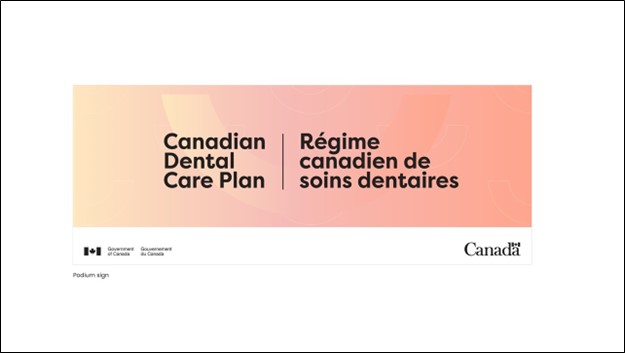
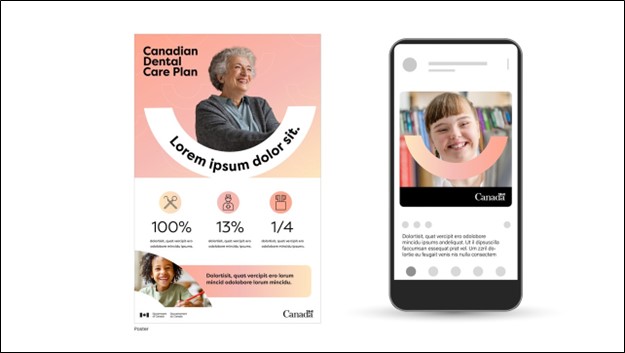



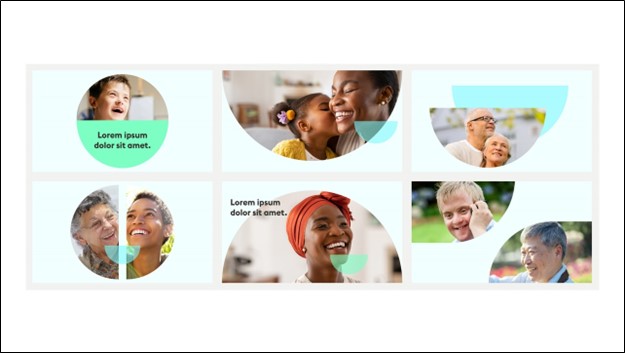
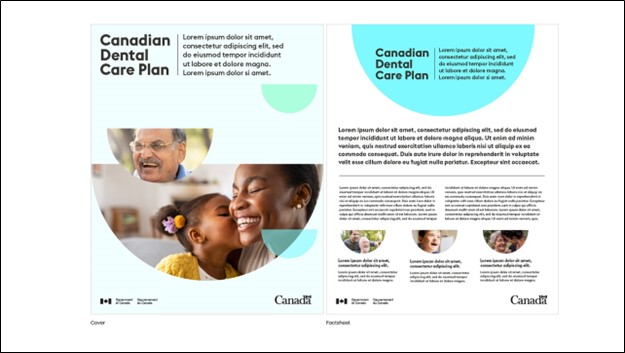

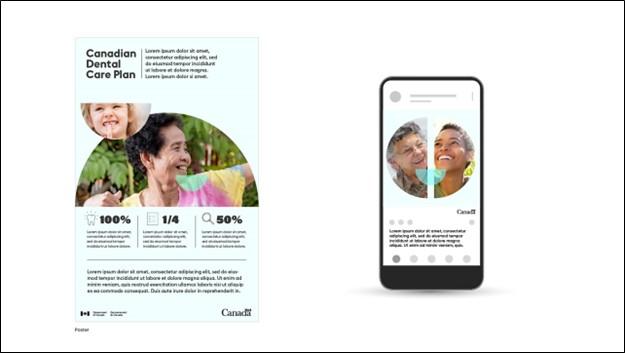





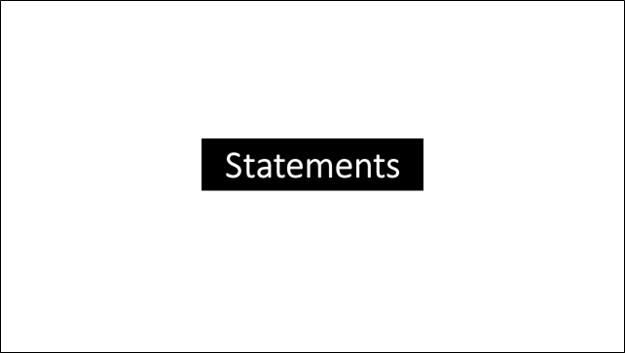
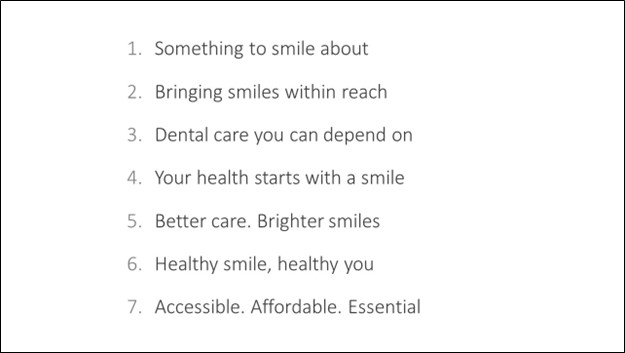
![Description: White question-mark in orange circle indicates a poll. The questions are posed, “Which [ad concept] is more likely to encourage you to search for more information on, or enroll for the Canadian Dental Care Plan?”, and, “Which one do you prefer?”](./images/poll2.jpg)













